
26
Oct
(Washington, D.C. October 26, 2016) ¬†With the Massachusetts Attorney General forcing Bayer CropScience to end its statewide advertising containing deceptive safety claims about bee-toxic pesticides, Beyond Pesticides yesterday asked the other 49 states to do the same. In a letter to State Attorneys General, Beyond Pesticides said, ‚ÄúWith neonicotinoid (neonic) insecticides linked to the increase in pollinator decline, we are writing to urge you, on behalf of our members in your state, to stop misleading and fraudulent advertising of these pesticide products.‚ÄĚ
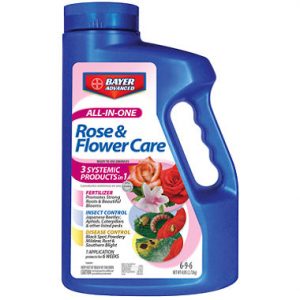 Beyond Pesticides continues, ‚ÄúWe make this request following the settlement reached by Massachusetts Attorney General Maura Healy with Bayer CropScience, announced today, that ends the company‚Äôs deceptive advertising practices on their neonicotinoid-containing lawn and garden products.‚ÄĚ
Beyond Pesticides continues, ‚ÄúWe make this request following the settlement reached by Massachusetts Attorney General Maura Healy with Bayer CropScience, announced today, that ends the company‚Äôs deceptive advertising practices on their neonicotinoid-containing lawn and garden products.‚ÄĚ
Bayer agreed to change its advertising practices, so that the neonic-containing lawn and garden products are no longer misrepresented by false safety claims. This landmark settlement, filed under the state‚Äôs Consumer Protection Act, is believed to be the first time any major pesticide company has agreed to a court order to address alleged false advertising regarding risks posed by neonic products to honey and native bees, and other pollinator species. ¬†The lawn and garden products subject to the settlement, which include Bayer Advanced ¬ģ All-in-One Rose and Flower Care, Bayer Advanced ¬ģ 12 Month Tree & Shrub Protect and Feed II, and Bayer Advanced ¬ģ Season Long Grub Control Plus Turf Revitalizer, contain the active ingredients imidacloprid and/or clothianidin, both neonics.
In addition, according to the Massachusetts AG, Bayer is paying the Commonwealth $75,000 to settle these claims against the company. Attorney General Healy stated that, ‚ÄúThis company was misleading consumers with deceptive claims, including falsely advertising its products as akin to giving ‚ÄĚňúa daily vitamin‚Äô to plants, when, in fact, the pesticides are highly toxic to honey bees and other pollinators in the environment. This groundbreaking settlement will promote truth in advertising for consumer products that expose bees to harmful pesticides and will increase awareness about the risks these pesticides pose to bees and other pollinators essential for food production.‚ÄĚ
Neonics are a class of insecticides with a common mode of action that affects the central nervous system of insects. There is extensive evidence that neonic pesticides play a major role in recent pollinator declines. Neonics decrease learning, foraging and navigational ability of bees, as well as increase their vulnerability to pathogens and parasites as a result of the suppression of bee immune systems. In addition to toxicity to bees, neonics have been shown to also adversely affect birds, aquatic organisms, and biodiversity, while contaminating soil and waterways. They are persistent in the environment and, because they are systemic, translocate throughout the plant and are expressed in the pollen, nectar, and guttation droplets, causing indiscriminate poisoning of wildlife.
Given the shortcomings in federal oversight of misleading labeling claims and the use of neonicotinoids, Beyond Pesticides asked State Attorney General  offices take action to mitigate these concerns. With growing concerns surrounding the detrimental role that neonics have on pollinator health, we applaud the actions taken by the Massachusetts Attorney General and urge other states to assess the pesticide labeling practices and take appropriate action. Farm, beekeeper, and environmental groups, including Beyond Pesticides, have urged EPA to follow the lead of the European Union and restrict neonics.
Download a copy of the letter here: http://bit.ly/NeonicAGLetter.
See a copy of our  press release here.
Read the Massachusetts Attorney General’s press release here.
See the science on neonicotinoids and other efforts to protect pollinators from pesticides.
All unattributed positions and opinions in this piece are those of Beyond Pesticides.
Posted in Announcements, Bayer, Chemicals, Genetic Engineering, Massachusetts, National Politics, neonicotinoids, Pesticide Residues, Pollinators, State/Local by: Beyond Pesticides
No Comments
26
Oct
(Beyond Pesticides, October 26, 2016) The U.S. Environmental Protection Agency (EPA) has launched a criminal investigation at several locations in Missouri into the illegal spraying this summer of the herbicide dicamba. EPA’s investigation is ongoing and stems from widespread complaints of damage to various crops across Missouri and several other states in the Midwest and Southeast. Dicamba, a widely used herbicide, has had frequent problems with drift and subsequent crop injury. Many suspect that ¬†farmers who planted the new dicamba-tolerant genetically engineered (GE) seeds in the region, when faced with a proliferation of pigweed this year, illegally sprayed dicamba across their fields, leading to drift and off-site crop damage to other farmers. While USDA has deregulated (approved) dicamba-tolerant crops, EPA is expected to but has not yet registered a formulations of dicamba for use on GE crops. Dicamba is highly volatile and prone to drift.
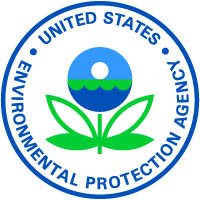 In a statement to the Arkansas Democrat-Gazette, EPA’s Region 7 office said the Missouri Department of Agriculture received more than 100 complaints since June 22, 2016. The complaints allege damage to more than 41,000 acres of soybeans, and other crops including peaches, tomatoes, watermelons, cantaloupe, rice, purple-hull peas, peanuts, cotton and alfalfa; as well as to residential gardens, trees and shrubs. More than 25 similar complaints were lodged with the Arkansas Department of Agriculture’s Plant Board, with most coming from Mississippi and Craighead counties in northeast Arkansas. Those complaints are being looked into by plant board investigators.
In a statement to the Arkansas Democrat-Gazette, EPA’s Region 7 office said the Missouri Department of Agriculture received more than 100 complaints since June 22, 2016. The complaints allege damage to more than 41,000 acres of soybeans, and other crops including peaches, tomatoes, watermelons, cantaloupe, rice, purple-hull peas, peanuts, cotton and alfalfa; as well as to residential gardens, trees and shrubs. More than 25 similar complaints were lodged with the Arkansas Department of Agriculture’s Plant Board, with most coming from Mississippi and Craighead counties in northeast Arkansas. Those complaints are being looked into by plant board investigators.
In its statement, EPA said officials served federal search warrants during the week of Oct. 10 at “several locations in Cape Girardeau, Dunklin, New Madrid and Stoddard counties” of Missouri. The warrants were issued by a U.S. magistrate judge in Cape Girardeau “for the expressed purpose of gathering evidence of possible violations” of federal law governing the use of herbicides and regarding “other federal crimes,” according to the statement.
In 2015, the U.S. Department of Agriculture (USDA) approved the dicamba-tolerant cotton, soybean and corn seed as a method to control glyphosate-resistant ‚Äúsuperweeds,‚ÄĚ which have spread as a result of the use of Roundup Ready on GE herbicide-tolerant crops. However, EPA has not yet approved the new dicamba product formulation for use on the new dicamba-tolerant crops. Current allowable uses for dicamba products are restricted to pre-plant and post-harvest burndown applications. The new formulation of dicamba is said to be lower in volatility than the other versions of dicamba. However, data on this has not been made public for peer review, and the validity of these claims remain unsubstantiated. Monsanto, the manufacturer of these GE seeds, ¬†told NPR ¬†that it made clear to farmers that they could not spray dicamba on its dicamba-tolerant crops.
Pesticide drift is an inevitable problem of pesticide application, and dicamba drift and subsequent crop injury to sensitive broadleaf crops has been a frequent problem. Abnormal leaf growth, floral development, reduced yield, and reduced quality have all been observed from dicamba drift. ¬†A ¬†study published by Pennsylvania State scientists ¬†in late 2015 found dicamba drift was ‚Äúfrequently responsible for sublethal, off-target damage‚ÄĚ to plants and insects. Researchers found that even very low rates of dicamba herbicide exposure negatively affected plant flowering, and thus insect pollination. Historically, to mitigate against potential risks from pesticide drift EPA has required buffer zones and application restrictions. However, these have not been sufficient to alleviate off-site crop damage and environmental contamination. Additionally, as demonstrated with these incidents, there are challenges with pesticide product label compliance.
The use of other highly volatile herbicides like 2,4-D on GE crops also presents growing pesticide drift concerns in light of new 2,4-D tolerant GE varieties. With lawmakers  contemplating increasing fines  on illegal pesticide applications in Missouri, ultimately, this problem will need to be addressed on a more comprehensive scale, as conventional farmers will need to diversify the crops they plant and implement other cultural practices to deter weeds, including using cover crops, crop rotation, and intercropping. Food distribution systems will also need to shift to accommodate greater diversity in farmer fields.  Organic agriculture  represents a time-tested approach to managing weeds and avoiding resistance problems that plague GE cropping systems. With organic, the use of toxic synthetic herbicides and GE seeds is prohibited, and farmers must craft an organic system plan aimed at improving soil health and managing pests and weeds should they arise.
All unattributed positions and opinions in this piece are those of Beyond Pesticides.
Source: Northwest Arkansas Democrat-Gazette  
Posted in Agriculture, Alternatives/Organics, Announcements, Chemicals, Contamination, Dicamba, Genetic Engineering, Missouri, State/Local by: Beyond Pesticides
No Comments
25
Oct
(Beyond Pesticides, October 25, 2016) Last week, a study,  Exposure to endocrine-disrupting chemicals in the USA: a population-based disease burden and cost analysis,  published in The Lancet  journal, concludes  that exposure to pesticides and other chemicals found in common household items, such as toys, makeup and detergent, costs the U.S. more than $340 billion annually in  health care costs and lost wages. The chemicals in question, endocrine disruptors (EDCs), interfere with the body’s hormone system, which can lead to a variety of health problems.
 According to Environmental Health News, the researchers estimate the costs by looking at exposure data and then projecting 15 medical conditions that are linked to endocrine disruptors and their associated health costs and lost wages. The findings came from calculations made by the Endocrine Society, the World Health Organization, and the United Nations Environment Program. A group of flame retardant chemicals called polybrominated diphenyl ethers (PBDEs) were the worst offenders in the U.S., accounting for nearly two-thirds of estimated health problems. These chemicals were estimated to annually cause about 11 million lost IQ points and 43,000 additional cases of intellectual disability, costing around $268 billion. Pesticide exposure, the second most costly chemical group in the U.S., causes an estimated 1.8 million lost IQ points and another 7,500 intellectual disability cases annual, with an estimated cost of $44.7 billion.
According to Environmental Health News, the researchers estimate the costs by looking at exposure data and then projecting 15 medical conditions that are linked to endocrine disruptors and their associated health costs and lost wages. The findings came from calculations made by the Endocrine Society, the World Health Organization, and the United Nations Environment Program. A group of flame retardant chemicals called polybrominated diphenyl ethers (PBDEs) were the worst offenders in the U.S., accounting for nearly two-thirds of estimated health problems. These chemicals were estimated to annually cause about 11 million lost IQ points and 43,000 additional cases of intellectual disability, costing around $268 billion. Pesticide exposure, the second most costly chemical group in the U.S., causes an estimated 1.8 million lost IQ points and another 7,500 intellectual disability cases annual, with an estimated cost of $44.7 billion.
Endocrine disruptors work either by mimicking naturally produced hormones, blocking hormone receptors in cells, or affecting the transport, synthesis, metabolism or excretion of hormones. These impacts can result in devastating effects on one’s health, including behavioral and learning disorders, such as Attention Deficit Hyperactivity Disorder (ADHD), birth defects, obesity, early puberty, infertility, cardiovascular disease, and childhood and adult cancers. Nearly 100 percent of people have detectable amounts of EDCs in their bodies, according to the introductory guide to EDCs published by the Endocrine Society and IPEN.
According to Environmental Health News, the American Chemistry Council, which represents chemical manufacturers, not surprisingly slammed the study, saying the research was speculative and the conclusions were based off of ‚Äúcherry-picked‚ÄĚ data. Leonardo Trasande, M.D., ¬†associate professor and researcher at the NYU School of Medicine, who is also the senior author of the study, countered that ¬†the estimates were actually on the conservative side. Researchers calculated the health-related costs from less than 5% of known endocrine disrupting chemicals. Philippe Grandjean, MD, a professor at Harvard‚Äôs School of Public Health, commented on the study, saying, ‚ÄúOf course it would be great to know more, but my prediction is that the calculated costs to society will increase substantially once we get better documentation on … additional substances and additional adverse effects.‚ÄĚ
Previous studies have shown that endocrine disrupting chemicals and other pesticides place a large burden of cost on the public through resulting health effects. In 2015, Dr. Grandjean co-authored a study showing that exposure to EDCs results in approximately √Ę‚Äö¬¨ 150 billion ($162 billion) in health care costs in the European Union each year. The analysis found (with 70-100% probability) that each year in Europe, 13 million IQ points are lost due to prenatal organophosphate exposure (pesticides such as chlorpyrifos and malathion), and 59,300 additional cases of intellectual disability are caused. Pesticides were found to be the most costly of the EDCs analyzed, accounting for √Ę‚Äö¬¨ 120 billion ($130 billion) of the estimated √Ę‚Äö¬¨ 150 billion ($162 billion) in healthcare expenditures each year. In July 2016, a study was released that showed lower IQ (intelligence quotient) in children born to mothers who during their pregnancy were living in close proximity to chemical-intensive agricultural lands where organophosphate pesticides were used. The researchers estimated that each one point decrease in IQ decreases worker productivity by approximately 2%, and reduces lifetime earnings of $18,000 (in 2005 market standards).
Ultimately, the widespread adoption of  organic management  is necessary to protect consumers in the long-term. While some may argue that organic is too expensive, the simple fact is that chemical companies are able to externalize the social cost of their products in the form of healthcare costs to consumers, and numerous other adverse effects. Consumers should not feel upset over paying the higher cost. In essence, organic shoppers are paying more to protect their health, the environment where the food is grown, the farmworkers that grow the food, the soil the food is growth in, and the pollinators and other wildlife in the area. If consumers paid the true cost of conventional food production, prices for conventionally grown goods would certainly be more expensive than organic products, which are certified through a process that protects human health and the environment. For the real story on the affordability of organic food, see our article here.
As we encourage more farmers to move toward organic, and more consumers to purchase organic foods, we must fight to keep organic strong. Consumers and producers can help maintain the integrity of the organic label, and thus protect the food we eat as well as the environment, by reading more about the issues. Currently, the National Organic Standards Board is accepting comments to protect organic standards until October 26. Click here to see the issues! For more information on the benefits of purchasing organic foods, see Beyond Pesticides’ Eating with a Conscience database, which documents the impacts on the environment and farmworkers of the toxic chemicals used in conventional agriculture.
Source: Environmental Health News
All unattributed positions and opinions in this piece are those of Beyond Pesticides.
Posted in Agriculture, Alternatives/Organics, Announcements, Disease/Health Effects, Endocrine Disruption, Health care by: Beyond Pesticides
No Comments
24
Oct
(Beyond Pesticides, October 24, 2016) Systemic neonicotinoid (neonic) exposure is associated with reductions in colony size and changes in foraging behavior, according to a recent field study done by a team of scientists at Imperial College London. The senior author of the study, Richard Gill, Ph.D., stated that when neonicotinoid ‚Äúexposure is relatively persistent and combined with other stressors associated with land use change, they could have detrimental effects at the colony level.‚ÄĚ
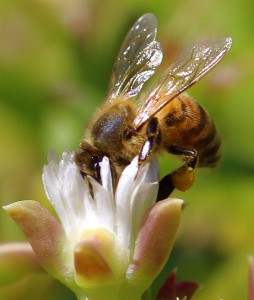 The study, Impact of controlled neonicotinoid exposure on bumblebees in a realistic field setting, assesses the effect of exposure to the neonic, clothianidin, on bumblebee foraging patterns and colony size. Clothianidin was given to 20 buff-tailed bumblebee colonies for five-weeks in a sugar solution at a concentration of 5 parts per billion, an environmentally relevant level of the pesticide. A bumblebee colony census was done before and after the field experiment, where the number of eggs, larvae, pupae, and workers bees were recorded along with the wax and pollen stores in the colony. The researchers found that the clothianidin treated colonies had fewer workers, drones and reproductive female bees compared to the colonies with no exposure. These data add to the growing body of research on sub-lethal effects, which must be considered when looking at the effects of pesticides on non-target organisms.
The study, Impact of controlled neonicotinoid exposure on bumblebees in a realistic field setting, assesses the effect of exposure to the neonic, clothianidin, on bumblebee foraging patterns and colony size. Clothianidin was given to 20 buff-tailed bumblebee colonies for five-weeks in a sugar solution at a concentration of 5 parts per billion, an environmentally relevant level of the pesticide. A bumblebee colony census was done before and after the field experiment, where the number of eggs, larvae, pupae, and workers bees were recorded along with the wax and pollen stores in the colony. The researchers found that the clothianidin treated colonies had fewer workers, drones and reproductive female bees compared to the colonies with no exposure. These data add to the growing body of research on sub-lethal effects, which must be considered when looking at the effects of pesticides on non-target organisms.
This study adds to the body of science that has  examined the effects of neonic exposure to  bee colonies under field conditions. However, neonic  pesticides  have long been identified as a major culprit in bee decline by independent scientists and beekeepers, yet chemical manufacturers like Bayer and Syngenta have focused on  other issues such as the varroa mite. As Beyond Pesticides wrote in the  2014 issue of  Pesticides and You, the issue of pollinator decline is  No Longer a Big Mystery, and urgent action is needed now to protect pollinators from these toxic pesticides.
Neonics are associated with  decreased learning,  foraging  and navigational ability, as well as increased vulnerability to pathogens and parasites as a result of suppressed bee immune systems. In addition to toxicity to bees, pesticides like neonicotinoids have been shown to also adversely affect  birds,  aquatic organisms and contaminate soil  and waterways, and  overall biodiversity.
These findings follow on the recent decision by the U.S. Fish and Wildlife Service (FWS) to add a group of bees to the Endangered Species List. FWS published a final rule in early October that declares seven species of yellow-faced bees that are native to Hawaii as endangered. This announcement follows the FWS’s proposed listing of the rusty patched bumble bee as an endangered species under the Endangered Species Act (ESA). FWS says that it needs additional time to identify specific areas to be designated as critical habitat for the endangered bees. Further, though FWS has identified many threats to bees, including habitat loss and degradation due to urbanization, and other human activities, the final rule does not specifically point to pesticides. However, there is an overwhelming number  of research studies  demonstrating that neonicotinoid insecticides, working either individually or synergistically, play a critical role in the ongoing decline of bees and other pollinators.
Over the past decade, ¬†numerous studies ¬†have illuminated the negative effect that ¬†neonics have on different pollinator species, but until now little research has been performed on the chemicals’ long-term impacts. The results of this recent study provide ¬†additional ¬†evidence that links the sublethal impacts of neonic exposure and large-scale population extinctions of wild bee species.
Despite limited ¬†action in the United States by federal agencies and Congress to discontinue the use of neonicotinoid insecticides and toxic pesticides in general, consumers and advocates around the country can create safe pollinator habitat and encourage local governments to do the same. Ultimately, the widespread adoption of‚Ä̬Įorganic management‚Ä̬Įis necessary to protect pollinators and the environment in the long-term. Farms or other land areas that are managed with chemical-intensive practices turn habitat into pollinator killing fields.
Beyond Pesticides has long sought a broad-scale marketplace transition to organic practices that prohibits the use of toxic synthetic pesticides by law and encourages a systems-based approach that is protective of health and the environment.‚Ä̬ĮFor information on growing plants to protect pollinators, see our ¬†Pollinator-Friendly Seeds and Nursery Directory. Use the ¬†Bee Protective Habitat Guide ¬†to plant a pollinator garden suited for your region, and consider ¬†seeding white clover into your lawn. You can also declare your garden, yard, park or other space as pesticide-free and pollinator friendly. Sign the pledge today! ¬† More information on the adverse effects neonics can be found in the Beyond Pesticides‚Äô report‚Ä̬ĮCultivating Plants that Poison.
Source: Science Daily, Imperial College London
All unattributed positions and opinions in this piece are those of Beyond Pesticides.
Posted in Agriculture, Alternatives/Organics, Announcements, Chemicals, Increased Vulnerability to Diseases from Chemical Exposure, neonicotinoids, Persistence, Pollinators, Wildlife/Endangered Sp. by: Beyond Pesticides
No Comments
21
Oct
(Beyond Pesticides, October 21, 2016) Last week, the U.S. Environmental Protection Agency (EPA) postponed ¬†a long-planned Scientific Advisory Panel (SAP) on the carcinogenicity of the widely used herbicide glyphosate due to ‚Äúrecent changes in the availability of experts for the peer review panel.‚ÄĚ ¬†However, as veteran journalist, formerly with Reuters, Carey Gillam reports in the Huffington Post, the move was likely the result of a letter industry front group CropLife America sent to EPA just days before the postponement, challenging the bias of certain experts on the panel. Croplife America is a national trade association that represents manufacturers, formulators, and distributors of pesticides, and has a vested interest in tamping down consumer concerns over glyphosate‚Äôs carcinogenicity.
 CropLife‚Äôs letter focuses in on two experts that were set to present in front of the EPA panel, Peter Infante, Dr.PH., and Kenneth Portier, PhD. CropLife writes that Dr. Infante will ‚Äúreflexively discount any and all industry sponsored studies‚Ä̬¶‚ÄĚ and indicates that his bias should preclude him from participation in the SAP. The group also asserts that Dr. Portier, who despite admission that ‚Äúhe has not previously testified against or otherwise expressed the patent bias against pesticide manufacturers,‚ÄĚ should not be completely disqualified from participation, but somehow vetted and confirmed by EPA that he will not approach the issue without preformed conclusions.
CropLife‚Äôs letter focuses in on two experts that were set to present in front of the EPA panel, Peter Infante, Dr.PH., and Kenneth Portier, PhD. CropLife writes that Dr. Infante will ‚Äúreflexively discount any and all industry sponsored studies‚Ä̬¶‚ÄĚ and indicates that his bias should preclude him from participation in the SAP. The group also asserts that Dr. Portier, who despite admission that ‚Äúhe has not previously testified against or otherwise expressed the patent bias against pesticide manufacturers,‚ÄĚ should not be completely disqualified from participation, but somehow vetted and confirmed by EPA that he will not approach the issue without preformed conclusions.
Biographies of members of the EPA glyphosate SAP cancer panel are available here and speak largely for themselves. According to ¬†Dr. Infante‚Äôs biography, which includes robust experience in government safety programs, ‚ÄúHe has served as an expert consultant in epidemiology for: the National Toxicology Program‚Äôs (NTP) Report on Carcinogens (RoC); for working groups of the International Agency for Research on Cancer (IARC); the EPA Science Advisory Board (SAB) Chemical Assessment Advisory Committee; and as an expert on cancer risk from asbestos exposure for the World Trade Organization (WTO).‚ÄĚ ¬†Despite this objectively deep experience, CropLife was concerned that he would be the only epidemiologist and would not emphasize studies the industry itself has put out about the safety of glyphosate.
Dr. Portier is the Vice President of the Statistics and Evaluation Center at the American Cancer Society, and, ‚Äúhas participated in over 60 FIFRA-SAP meetings since 1999 and five SAB science review panels. In addition, Dr. Portier has served on expert and advisory panels for the National Institutes ¬† of ¬† Health ¬† (NIH), ¬† National ¬† Institute ¬† of ¬† Environmental ¬† Health ¬† Sciences ¬† (NIEHS), ¬† the ¬† National Toxicology Program (NTP), and the World Health Organization Food and Agriculture Organization ¬† (WHO/FAO) in Geneva, Switzerland.‚ÄĚ However, CropLife believes Dr. Portier would not be an objective panel member because his brother is ‚Äúa noted and vehement anti-glyphosate activist.‚ÄĚ
These attacks on independent scientists, and  the American Cancer Society, represent a new low for the pesticide industry. EPA’s quick turnaround, apparently in response to CropLife criticims, postponed a meeting less than a week before it was to take place, for which plane tickets were purchased and was planned for months in advance, raises serious concerns that advocates say warrant an independent investigation on the objectivity of EPA’s approach to this issue.
Beyond Pesticides is concerned about what it views as incessant industry driven attacks on independent and government scientists. ¬†In 2015, one of the top entomologists at the U.S. Department of Agriculture (USDA) ¬†filed a whistleblower complaint ¬†against a ¬†federal agency, citing unprofessional retaliation following the publication of a ¬†study ¬†linking neonicotinoid insecticides to the decline of monarch butterflies. Jonathan Lundgren, Ph.D., former senior research entomologist and lab supervisor for the Agricultural Research Service (ARS) in South Dakota, faced suspension for publishing research deemed ‚Äúsensitive‚ÄĚ by his USDA superior, underscoring why legal protections for government scientists are sorely needed.
Glyphosate, which is produced and sold as RoundupTM ¬†by Monsanto, has been touted by industry and EPA as a ‚Äúlow toxicity‚ÄĚ chemical, ‚Äúsafer‚ÄĚ than other pesticides. It is widely used in food production and on lawns, gardens, parks, and children‚Äôs playing fields. In 2015, the IARC classified glyphosate as a Group 2A ‚Äúprobable‚ÄĚ carcinogen. According to IARC‚Äôs 2015 findings, Group 2A means that the chemical is probably carcinogenic to humans based on sufficient evidence of carcinogenicity in experimental animals. IARC considered the findings from a prior EPA Scientific Advisory Panel report, along with several recent studies in making its conclusion. The international organization also noted that glyphosate caused DNA and chromosomal damage in human cells. Further, epidemiologic studies have found that exposure to glyphosate is significantly associated with an increased risk of non-Hodgkin‚Äôs Lymphoma (NHL).
According another  review, Glyphosate pathways to modern disease V: Amino acid analogue of glycine in diverse proteins, conducted by independent scientists Anthony Samsel, Ph.D. and Stephanie Seneff, Ph.D., a scientist at Massachusetts Institute of Technology (MIT), glyphosate acts as a glycine analogue that  incorporates into peptides during protein synthesis. In this process, it alters a number of proteins that depend on conserved glycine for proper function. According to the authors, glyphosate substitution for glycine correlates with  several diseases, including diabetes, obesity, asthma, Alzheimer’s disease, amyotrophic lateral sclerosis (ALS), and Parkinson’s disease, among others.
EPA indicated to the Huffington Post that it was ‚Äúworking to reschedule as soon as possible.‚ÄĚ In order to ensure an outcome based on fact, and not industry spin, it is critical that EPA not continue to cave to industry pressure on this important issue. For more information about glyphosate‚Äôs carcinogenicity, see Beyond Pesticides fact sheet on glyphosate, or the 2015 article on the IARC decision in Pesticides and You, our quarterly newsletter.
Source: Huffington Post, EPA
Posted in Announcements, Chemicals, Glyphosate, National Politics, Pesticide Regulation by: Beyond Pesticides
No Comments
20
Oct
(Beyond Pesticides, October 20, 2016) Researchers at the University of Western Australia (UWA) and Murdoch University recently released a study whose findings show that levels of pesticides in breast milk have dropped significantly over the past forty years, though some major concerns remain. Published in the international journal Chemosphere, the research shows a 42-fold decrease in levels of pesticides detected in breast milk, and ties the reduction to government efforts to prohibit persistent organic pollutants (POPs) in Australia, which has lead to decreased exposure over time. Led by UWA’s internationally renowned human lactation researcher Emeritus Professor Peter Hartmann, Dr. Donna Geddes and Murdoch’s Associate Professor Robert Trengove, the study is a testament to the positive impact banning pesticides can have on the health of individuals, especially vulnerable populations like infants, but also shows that there is a long way to go before our bodies are void of any bioaccumulated toxic residues.
 Researchers often study breast milk because it can bioconcentrate, or accumulate, persistent organic pollutants (POPs). Multiple studies on breast milk have been performed throughout the years, many of them confirming the fact that common toxic chemicals, such as glyphosate and triclosan, build up in our bodies over time. Most people are unaware that they carry chemical compounds in their bodies, a natural phenomenon dubbed chemical ‚Äúbody burden.‚ÄĚ At any given time, hundreds of chemicals can be found in blood, urine, breast milk and even umbilical cord blood. Many of these chemicals enter our bodies through the foods we eat or drink, products we put on our skin and air we breathe. Before birth, people normally carry a body burden inherited from their mothers. Scientists believe the typical human being hosts close to 500 chemicals in various compartments in the body, mostly in fatty tissue. Many chemicals are broken down in our bodies and their metabolites are eliminated, but others linger in bodies for a lifetime and can increase the ¬†risk of ¬†certain diseases, such as ¬†cancer ¬†and ¬†Parkinson’s disease.
Researchers often study breast milk because it can bioconcentrate, or accumulate, persistent organic pollutants (POPs). Multiple studies on breast milk have been performed throughout the years, many of them confirming the fact that common toxic chemicals, such as glyphosate and triclosan, build up in our bodies over time. Most people are unaware that they carry chemical compounds in their bodies, a natural phenomenon dubbed chemical ‚Äúbody burden.‚ÄĚ At any given time, hundreds of chemicals can be found in blood, urine, breast milk and even umbilical cord blood. Many of these chemicals enter our bodies through the foods we eat or drink, products we put on our skin and air we breathe. Before birth, people normally carry a body burden inherited from their mothers. Scientists believe the typical human being hosts close to 500 chemicals in various compartments in the body, mostly in fatty tissue. Many chemicals are broken down in our bodies and their metabolites are eliminated, but others linger in bodies for a lifetime and can increase the ¬†risk of ¬†certain diseases, such as ¬†cancer ¬†and ¬†Parkinson’s disease.
For this study, researchers recruited 40 breastfeeding mothers and performed mass spectrometry tests to determine the levels at which their human milk (HM) showed the presence of 88 different pesticides. While traditional POPs, such as organochlorines, organophosphates, carbamates and pyrethroids, were not detected in HM, the study revealed that 87.5% of mothers tested positive for dichlorodiphenyldichloroethylene (DDE), the toxic chemical dichlorodiphenyltrichloroethane’s (DDT)‚Äôs major metabolite. DDT was banned in the U.S. in 1972, following a massive environmental movement spurred by Rachel Carson‚Äôs ¬†Silent Spring, which documents the adverse environmental effects resulting from the indiscriminate use of pesticides. Despite the fact that DDT was banned in the U.S. 43 years ago, concentrations of DDE have remained alarmingly high in many ecosystems, a fact supported by the prevalence of DDE in HM reported in this study.
Aside from the presence of DDE, the study does bring with it some positive findings, as researches point out that infants how have a daily intake of POPs 59-times below the amount that is considered safe. ‚ÄúIt‚Äôs really good news,‚ÄĚ said Professor Hartmann, Ph.D., while speaking to the problematic effects that ¬†the presence of pesticides can have on the growth and development of babies, ‚Äúsome of these compounds do mimic some of the body‚Äôs hormones‚Ä̬¶ so it is a bit of a problem if they are at high levels.‚ÄĚ He also reiterated that his research showed that legislation to ban pesticides in the 1970‚Äôs has had positive impacts on health. “The restriction of sale of these pesticides has had an enormous effect in bringing the levels down to very good levels,” he said.
The study specifically looks to the banning of POPs in the 1970’s to explain the reduction in pesticides found in breast milk. Chemicals such as organochlorine pesticides, organophosphate pesticides, pyrethroids and carbamate pesticide were classified as persistent organic pollutants because they remain for long periods of time in the environment, eventually making their way up food chains, accumulating in the fatty tissues and animals and humans. Their  legacy of poisoning the environment  has been well documented, despite being banned for decades. Recent studies have linked these POPs to  hormonal disturbances,  abnormal sperm development,  cancer,  diabetes,  obesity  and  environmental contamination.
To find out more about the impacts of pesticides on your health, please visit our Pesticide-Induced Diseases Database. You can also support organic food practices that reduce or eliminate our reliance on toxic pesticides by Eating with a Conscience.
All unattributed positions and opinions in this piece are those of Beyond Pesticides.
Source: University of Western Australia
Posted in Announcements, Cancer, Diabetes, Disease/Health Effects, International, Obesity, Pesticide Residues by: Beyond Pesticides
No Comments
19
Oct
(Beyond Pesticides, October 19, 2016) Reckitt Benckiser, the company that fought tooth and nail to keep its highly toxic d-CON ¬ģ anticoagulant rodenticides on the market in the U.S., has recently issued an apology for another product of theirs that ¬†is responsible for the deaths of pregnant women and children in Korea: humidifier disinfectants. According to The Wall Street Journal, 189 deaths and 506 injuries from humidifier disinfectants, primarily Reckitt Benckiser‚Äôs humidifier disinfectant, Oxy Sac Sac (Oxy). The main ingredient in the sanitizers found to be toxic is polyhexamethylene guanidine phosphate, or PHMG.
 In a statement on Wednesday, September 21, Reckitt Benckiser CEO Rakesh Kapoor offered his ‚Äúdeepest sympathy‚ÄĚ for ‚Äúthe pain and the irreparable damage suffered by many families.‚ÄĚ The apology was made during a visit with Oxy victims and ¬†families, as well as representatives of the Korean National Assembly Special Committee at the Company‚Äôs headquarters in Slough, UK.
In a statement on Wednesday, September 21, Reckitt Benckiser CEO Rakesh Kapoor offered his ‚Äúdeepest sympathy‚ÄĚ for ‚Äúthe pain and the irreparable damage suffered by many families.‚ÄĚ The apology was made during a visit with Oxy victims and ¬†families, as well as representatives of the Korean National Assembly Special Committee at the Company‚Äôs headquarters in Slough, UK.
Hazards associated with the humidifier disinfectants were first discovered in 2011 when seven pregnant women were hospitalized with acute respiratory disease, resulting in four deaths from  lung failure. Korean Center for Disease Control (KCDC) led an investigation that found that the chemicals used to clean humidifiers were to blame, and the Korean government recalled six humidifier disinfectant products from the market nationwide, while recommending against the use of other similar products and ordered a voluntary recall in 2011.
According to The Wall Street Journal, the company commissioned Seoul National University, Hoseo University and Korea Conformity Laboratories to test its humidifier disinfectant, and privately hired two researchers from the universities as consultants. The company then purportedly rejected test results showing its products were unsafe, bribed the researchers to create favorable results and ignored toxicity warnings about its product in 2000, according to the Journal. Former CEOs and officials at Reckitt Benckiser Korea were charged in May and fined for and evading necessary toxicity tests before introducing it to market in South Korea in 2001, falsely advertising their product as ‚Äúsafe for humans.‚ÄĚ
Reckitt Benckiser’s humidifier disinfectants are not sold outside of South Korea, however the multi-national company has a history of selling products that are known to be hazardous to children. In the U.S., Reckitt Benckiser, well known as the manufacturer of d-CON mouse and rat control products, refused to adopt EPA safety standards despite known health and safety risks.
Between 1993 and 2008, the American Association of Poison Control Centers logged somewhere in the range of 12,000 to 15,000 reports of rat and mouse poison exposures each year for children under the age of six. These numbers and other concerns about pet and non-target wildlife exposures spurred EPA to renew its efforts to establish better protections for children and the environment. Children are particularly susceptible to these risks because they play on floors and explore by putting items in their mouths, which can include loose rat poisons like d-CON.
The company refused to abide by EPA’s 2013 cancellation order of 12 of its products for not meeting statutory risk mitigation measures established by the agency in 2008. These measures required that products be sold in bait stations and secured bait forms, instead of loose baits that children can more readily access, and not contain the most toxic and persistent active ingredients.
The company challenged EPA’s decision keeping products on shelves for over one year, even suing the state of California for enacting EPA’s order to remove the products from shelves. This was the first time in more than 20 years that a company declined to implement EPA risk mitigation measures for pesticide products. Eventually, Reckitt Benckiser agreed to phase out production of the products under question in June 2014, nearly eight years after EPA warned about the threats to children’s health, however existing stocks may continue to be sold at retail stores.
While Reckitt-Benckiser outlined a compensation plan to the victims and their family members in South Korea, and has vowed to review its safety process, no plans to remove the products from market have been identified. Meanwhile, major retailers in South Korea have stopped selling Reckitt Benckiser products, which also includes such popular brands as Durex condoms, Air Wick and Lysol. For more information, including victim’s stories and a timeline of the history of Reckitt Benckiser’s hazardous humidifier disinfectant in South Korea, see the Asian Network for the Rights of Occupational and Environmental Victims (ANROEV), a coalition of victims’ groups, trade unions and other labor groups across Asia, committed to the rights of Victims and for overall improvement of health and safety at the workplace.
All unattributed positions and opinions in this piece are those of Beyond Pesticides.
Sources: Wall Street Journal, Asian Network for the Rights of Occupational and Environmental Victims (ANROEV) and The Korea Herald
Photo Source:  Asian Network for the Rights of Occupational and Environmental Victims (ANROEV)
Posted in Alternatives/Organics, Announcements, Corporations, International, Litigation, Pesticide Regulation, Pesticide Residues, Reckitt Benckiser, Rodenticide by: Beyond Pesticides
No Comments
18
Oct
(Beyond Pesticides, October 18, 2016) A Wisconsin family is speaking out against groundwater contamination after their son fell ill two years ago, prompting them to test their well water. The test results found the water contaminated with fertilizers and pesticides, most notably the weed killer atrazine, which has been banned in their area for 20 years. Atrazine has been registered for use since 1958. Although many residential turf grass uses of the chemical have been eliminated voluntarily, homeowner uses do persist. The chemical has been linked to human health impacts such as childhood cancer, and rare birth defects, including gastroschisis, and choanal atresia.
 According to Minnpost, in the spring of 2014, Jacob, son of Doug and Dawn Reeves, fell mysteriously ill. His body became swollen and he developed an unusual rash. He was finally diagnosed with juvenile dermatomyositis, a rare inflammatory disease that affects the muscles, skin and blood vessels. The cause of the disease is unknown, so the Reeves family began their own hunt as to why Jacob became sick. When they received the test results from Wisconsin State Laboratory of Hygiene, it showed that their well contained atrazine at twice the state and federal drinking water health standard. Follow up testing by the state Department of Agriculture, Trade and Consumer Protection (DATCP) found 8.2 parts per billion of atrazine ‚ÄĒ almost triple the state health standard.
According to Minnpost, in the spring of 2014, Jacob, son of Doug and Dawn Reeves, fell mysteriously ill. His body became swollen and he developed an unusual rash. He was finally diagnosed with juvenile dermatomyositis, a rare inflammatory disease that affects the muscles, skin and blood vessels. The cause of the disease is unknown, so the Reeves family began their own hunt as to why Jacob became sick. When they received the test results from Wisconsin State Laboratory of Hygiene, it showed that their well contained atrazine at twice the state and federal drinking water health standard. Follow up testing by the state Department of Agriculture, Trade and Consumer Protection (DATCP) found 8.2 parts per billion of atrazine ‚ÄĒ almost triple the state health standard.
While there is currently no link between atrazine exposure and juvenile dermatomyositis, the DATCP warned in a letter that, ‚ÄúLong-term exposure to atrazine may cause a variety of health problems, including weight loss, heart damage and muscle spasms.‚ÄĚ Testing also revealed 19.2 parts per million of nitrate, which is almost double the state health standard of 10ppm. Nitrate is a common groundwater contaminant that is sourced mainly from chemical fertilizers and animal waste, and has been linked to birth defects, cancers and thyroid problems.
Wisconsin regulators have already taken steps to mitigate the effects of atrazine. In 1991, the state created a rule that allowed DATCP to set maximum application rates and even prohibit the use of atrazine in certain areas. The last update was in 2011, with 101 prohibition areas covering 1.1 million acres. Unfortunately for the Reeves family, these restrictions were not enough. Their well was poisoned even though they are in the middle of a prohibition zone where atrazine use is banned. The Reeves family has installed filtration systems to remove the contaminants, but are worried about other chemicals.
Stan Senger, DATCP‚Äôs environmental quality section chief, expressed similar concerns. ‚ÄúMy biggest concerns are in the cocktail of very low impacts of pesticides and their metabolites that are showing up in wells,‚ÄĚ Mr. Senger said to Minnpost. ‚ÄúSo you‚Äôll find four or five of these pesticide components in a water sample, and you don‚Äôt know what to tell the homeowners.‚ÄĚ Joanna Ory, a USDA National Institute of Food and Agriculture pre-doctoral fellow at the University of California-Santa Cruz, who studied Wisconsin‚Äôs approach to atrazine, stated to Minnpost that, ‚ÄúThere may be negative synergistic effects if groundwater contains a ‚ÄĚňúchemical soup‚Äô of pesticides.‚ÄĚ
There is a growing body of research on the interactive effects of pesticides on human health and the environment. A 2002 ¬†study by Warren Porter, PhD., professor of zoology and environmental toxicology at the University of Wisconsin, Madison, examined the effect of fetal exposures to a mixture of 2,4-D, mecoprop, and dicamba exposure ‚ÄĚ‚ÄĚfrequently used in lawn products like Weed B Gone Max and Trillion, and in conventional agriculture ‚ÄĚ‚ÄĚon the mother‚Äôs ability to successfully bring young to birth and weaning. Researchers looked at pesticide concentrations diluted to levels that are considered ‚Äúsafe‚ÄĚ by EPA and found that it is capable of inducing abortions and resorptions of fetuses at very low parts per billion. The greatest effect was at the lowest dose. For more information on pesticide synergy, see our 2004 article, ‚ÄúSynergy: The Big Unknowns of Pesticide Exposure.‚ÄĚ
Drinking water treatment plans and filtration systems are a short-term, band-aid option to a problem that is persistent and must be addressed through preventive, long-term solutions. Beyond Pesticides has long supported ‚Äúfeed-the-soil‚ÄĚ approaches to all types of landscape management. Understanding the role of healthy soils in creating healthy landscapes and plants, Beyond Pesticides promotes a systems approach that centers on management of soil health and proper fertilization that eliminates synthetic fertilizers and focuses on building the soil food web and nurturing soil microorganisms.
Organic farming and land management uses natural, less soluble sources of nitrogen, phosphorous and magnesium; including cover crops, compost, manure and mineralized rock, in order to promote increases in soil organic matter and a healthy soil structure. Healthy soil structure allows water to infiltrate the ground slowly, rather than escaping across the surface and carrying soil particles, nutrients, and other inputs with it. Also, it allows plants to establish vibrant root systems that resist erosion. For more details, see Beyond Pesticides fact sheet  Organic Land Management and the Protection of Water Quality.
Source: Minnpost
All unattributed positions and opinions in this piece are those of Beyond Pesticides.
Posted in Agriculture, Alternatives/Organics, Announcements, Atrazine, Chemicals, Pesticide Regulation, State/Local, Water, Water Regulation, Wisconsin by: Beyond Pesticides
1 Comment
17
Oct
(Beyond Pesticides, October 17, 2016) The U.S. Environmental Protection Agency (EPA) revealed its plan last Friday to register the toxic chemical sulfoxaflor, in the face of  overwhelming evidence that it negatively affects bee populations. This decision is the final result of a long-fought legal battle over the chemical’s registration, spearheaded by beekeepers and public health organizations concerned with what has been identified as EPA’s inadequate and flawed pesticide review processes. The agency claims that amendments made to the original registration, such as reducing the number  of crops for which use is permitted or only allowing post-bloom applications, will protect pollinators. However, scientific studies have shown that there is no way to fully limit exposure to bees, especially native species that exist naturally in the environment, given that the chemical, being systemic, is found in pollen, nectar, and guttation droplets. Given the evidence of harm related to sulfoxaflor’s use, as well as its demonstrated lack of need, advocates maintain that the agency’s decision to issue an amended registration violates its  duty to protect human health and the environment.
Sulfoxaflor‚Äôs initial 2013 registration was challenged by beekeepers and subsequently vacated by the Ninth Circuit Court of Appeals due to overwhelming risks to be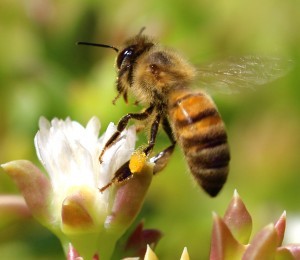 es and EPA‚Äôs inadequate review of the data. Last September, the ¬†Ninth Circuit Court of Appeals unequivocally rejected ¬†EPA‚Äôs registration of sulfoxaflor. The Court concluded that EPA violated federal law when it approved sulfoxaflor without reliable studies regarding the impact that the insecticide may ¬†have on honey bee colonies. By vacating EPA‚Äôs unconditional registration of the chemical, sulfoxaflor could no longer be used in the U.S. This decision was issued, at least in part, as a response to a ¬†suit filed by beekeepers challenging EPA‚Äôs initial registration of sulfoxaflor, which cited the insecticide‚Äôs threat to bees and beekeeping. The case was ¬†Pollinator Stewardship Council, American Honey Producers Association, National Honey Bee Advisory Board, American Beekeeping Federation, Thomas Smith, Bret Adee, Jeff Anderson v. U.S. EPA ¬†(9th Circuit U.S. Court of Appeals,‚Ä̬ĮNo. 13-7234). As a result of this favorable holding, a similar lawsuit was filed by European beekeepers, who asked the European Court of Justice to take the same action.
es and EPA‚Äôs inadequate review of the data. Last September, the ¬†Ninth Circuit Court of Appeals unequivocally rejected ¬†EPA‚Äôs registration of sulfoxaflor. The Court concluded that EPA violated federal law when it approved sulfoxaflor without reliable studies regarding the impact that the insecticide may ¬†have on honey bee colonies. By vacating EPA‚Äôs unconditional registration of the chemical, sulfoxaflor could no longer be used in the U.S. This decision was issued, at least in part, as a response to a ¬†suit filed by beekeepers challenging EPA‚Äôs initial registration of sulfoxaflor, which cited the insecticide‚Äôs threat to bees and beekeeping. The case was ¬†Pollinator Stewardship Council, American Honey Producers Association, National Honey Bee Advisory Board, American Beekeeping Federation, Thomas Smith, Bret Adee, Jeff Anderson v. U.S. EPA ¬†(9th Circuit U.S. Court of Appeals,‚Ä̬ĮNo. 13-7234). As a result of this favorable holding, a similar lawsuit was filed by European beekeepers, who asked the European Court of Justice to take the same action.
Sulfoxaflor, the chemical at issue, is a relatively new active ingredient, registered in 2013, whose mode of action is similar to that of neonicotinoid pesticides. Even though it has not been classified as a neonicotinoid, it elicits similar neurological responses in honey bees, with many believing that sulfoxaflor is the new generation of neonicotinoid. Neonicotinoids, as well as ¬†sulfoxaflor, are “systemic‚ÄĚ insecticides, which means that they are applied to plants, they are absorbed and distributed throughout the plant, including pollen, and nectar. Sulfoxaflor was previously registered in the U.S. for use on vegetables, fruits, barley, canola, ornamentals, soybeans, wheat and others, but the amended registration removes citrus, cotton, cucurbits, soybeans and strawberries from that list. This reduction, though aimed at protecting pollinators, comes up short. Like nenonicotinoids, sulfloxoflor has a long half-life and persists in soil, where it is ¬†taken up by growing plants, presenting itself in the nectar and pollen that pollinators rely on for food. Because it can last in the environment into the next growing season, efforts to protect pollinators by mitigating measures, such as not spraying while crops are in bloom, do not do enough to protect bees.
In an effort to stop the amended registration from going through, public comments were submitted by concerned beekeepers and environmental advocacy groups, like Beyond Pesticides, that stated that approval of a pesticide highly toxic to bees would‚Ä̬Įonly exacerbate the problems‚Ä̬Įfaced by an already tenuous honey bee industry and further decimate bee populations. However, EPA dismissed these concerns and instead pointed to a need for sulfoxaflor by industry and agriculture groups for justification, claiming they need it to control insects no longer being controlled by increasingly ineffective pesticide technologies. The comment period closed earlier this summer, and the recently issued amended registration indicates that the concerns of beekeepers and environmental groups were not addressed, as EPA believes these restrictions will ‚Äúpractically eliminate exposure to bees on the field, which reduces the risk to bees below EPA‚Äôs level of concern such that no additional data requirements are triggered,‚ÄĚ despite comments submitted showing evidence to the contrary.
Honey bees and wild bees have been suffering elevated population declines over the last few years. A recent government-sponsored survey reports that U.S. beekeepers  lost  44 percent of their honey bee colonies  between April 2015 and April 2016, one of the highest recorded losses.  A  recently published study  by researchers at Purdue University  found that honey bees collect most of their pollen from non-crop plants that are frequently contaminated with a wide range of pesticides. Numerous pesticides, including sulfoxaflor, neonicotinoids, pyrethroids, and fungicides are highly toxic to honey bees and have a range of effects including impacts on learning behavior, foraging, reproduction and queen production, as well as impairing bee immune systems making them more susceptible to parasites and disease.
In light of the ¬†shortcomings of federal action‚Ä̬Įto protect these beneficial ¬†organisms, ¬†pollinators need pesticide-free habitat ¬†throughout communities. You can declare your garden, yard, park or other space as pesticide-free and pollinator friendly. It does not matter how large or small your pledge is, as long as you contribute to the creation of safe pollinator habitat.‚Ä̬ĮSign the pledge today! Need ideas on creating the perfect pollinator habitat? The‚Ä̬ĮBee Protective Habitat Guide‚Ä̬Įcan tell you which native plants are right for your region. For more information on what you can do, visit our ¬†BEE Protective ¬†page.
All unattributed positions and opinions in this piece are those of Beyond Pesticides.
Source: U.S. Environmental Protection Agency
Posted in Announcements, Chemicals, Litigation, National Politics, Pesticide Regulation, Pollinators, Sulfoxaflor by: Beyond Pesticides
1 Comment
14
Oct
(Beyond Pesticides, October 14, 2016) A recent study has shown that the interaction between pesticides, tillage and soil fertilization can have an effect on soil organisms. The study demonstrates that simple evaluations of pesticide exposure on single organisms does not give a complete picture of pesticide risk, and the authors of the study conclude that a more realistic risk assessment was needed to fully encompass the complex factors that can influence the effects of pesticides.
The study, titled Pesticide Interactions with Tillage and N Source, Effects on fauna, microoganisms and selected ecosystem services, monitored soil biota during two cropping seasons of winter wheat. The researchers studied pesticide effects in both moldboard plowed soil and directly seeded (no-till) soil. Either mineral fertilizer or cattle slurry was applied to the soil, along with either a fungicide, an insecticide, or both. Following the application of pesticides in the spring, and again after the winter wheat harvest in September, researchers studied how the populations of earthworms, springtails, mites and microbial life were affected. Researchers observed a negative effect due to pesticide treatment on mites, and generally found that all taxonomic groups were affected negatively, especially following insecticide treatment.
When looking at the effects of direct seeding versus plowed, and the addition of cattle slurry versus mineral fertilizer, researchers found that there was a higher population of soil biota in the soil under direct seeding versus plowed soil, and a positive effect from the addition of cattle slurry as opposed to the mineral fertilizer. Pesticide effects on soil organisms were also examined after the incubation of soil columns. Researchers found that soil biota populations were greater in the soil that had been directly seeded compared to plowed soil.
According to the conclusion of the study, ‚ÄúThis project demonstrated a complex interaction between management factors that should be considered in risk assessments, for example by supplementing traditions dose-response tests with more realistic test systems that can also take indirect effects into account. Negative effects of pesticides on populations occurred in this project mainly at highly elevated doses, but also sublethal effects, and changes in species composition, are important, as loss of biodiversity can reduce the robustness of cropping systems towards, e.g., climate change.‚ÄĚ
Other studies have demonstrated the detrimental effects that a wide range of pesticides can have on earthworms and other soil biota. A 2015 study demonstrated that glyphosate, the controversial and toxic active ingredient in Roundup, reduces activity and reproduction in two species of earthworms and increases soil nutrient concentrations to dangerous levels. Another study on worms found that chronic and/or acute exposure to glyphosate and/or mancozeb promotes neurodegeneration in GABAergic and DAergic neurons in Caenorhabditis elegans, a type of roundworm. In 2014, researchers also found that earthworms exposed to fungicides in conventionally farmed soil are at a stark disadvantage to worms in land managed organically. Earthworms exposed to the fungicide epoxiconazole  are able to detoxify the chemical, but gain half as much weight as worms from an organic farm, where their population is also 2 to 3 times higher.
Soil biota is  essential to ecosystem functioning because it  breaks down organic matter, enables chemical elements to be reused, and fixes  nitrogen, which is necessary for nutrient cycling in  the ecosystem. A study published in February 2016 reveals  that a decrease in soil biota impacts the services that healthy soil provides. The study finds that soil microbial diversity  positively relates to multi-functionality in terrestrial ecosystems. Simply put, when soil diversity is high, the soil can function more efficiently and provide a multitude of ecosystem services. Any loss in microbial diversity will likely reduce multi-functionality, negatively affecting  the services provided by soil, such as climate regulation through atmospheric carbon sequestration, fertility, and productivity. A  further decline in soil biodiversity has adverse economic  impacts as well. The European Academies’ Science Advisory Council (EASAC) estimates soil organisms and their role in agricultural productivity to be worth $25 billion a year, globally.
One way to protect soil biota, other wildlife, biodiversity, and the ecosystem as a whole from the harmful effects of pesticides is to support organic agriculture over conventional, chemical-intensive farming. Beyond Pesticides supports organic agriculture as effecting good land stewardship. The pesticide reform movement, citing pesticide problems associated with chemical agriculture, from groundwater contamination and runoff to drift, views organic as the solution to this serious environmental threat. It is impossible to discuss the ecological benefits of organic agriculture without discussing the devastating effects of conventional agriculture.
Conventional, or chemical-intensive, agriculture relies on toxic pesticides that contaminate air, water, soil, and living things; organic agriculture does not allow the use of toxic pesticides. Chemical-intensive  agriculture relies on synthetic chemical fertilizers that reduce soil organic matter and contaminate waterways; organic agriculture does not permit the use of synthetic  fertilizers and relies instead on nutrient sources that tend to be less soluble and more stable in the soil, because of the expectation that healthy soil will produce microbes that  can make the nutrients naturally available over a longer period of time.
To learn more about the impacts of pesticides on wildlife (which includes soil biota), visit Beyond Pesticides’ Wildlife Page  for a  discussion of how organic systems protect  wildlife from the dangerous impacts of pesticides, encourage them to flourish, and restore the natural balance that is unable to exist in chemical-intensive  agriculture.
Source: Eurekalert
All unattributed positions and opinions in this piece are those of Beyond Pesticides.
Posted in Uncategorized by: Beyond Pesticides
1 Comment
13
Oct
(Beyond Pesticides, October 13, 2016) Last week, the California Department of Pesticide Regulation (CDPR) released new rules that allow for continued use of the toxic fumigant Telone and reduce public health protection by permitting increased usage. One of the active ingredients in the product Telone, ¬†1,3-Dicholorpropene (1,3-D), has many documented health risks, including cancer and kidney and liver damage. While CDPR and many news outlets reported the rule change as a tightening of the restrictions, the new rules effectively increase the previous annual cap from 90,250 pounds to 136,000 pounds per township, a defined area of 6×6 miles.
 According to CDPR documents, the primary revisions include: increasing the annual limit to 136,000 pounds within each pesticide township, eliminating ‚Äúrollover‚ÄĚ of unused pesticide allotments from prior years, and banning use of Telone in December, when weather conditions are especially problematic for air pollution. These new rules, which go into effect January 1, will allow for 1,3-D‚Äôs continued use in strawberry fields, vineyards, almond orchards, and other crops around California.
According to CDPR documents, the primary revisions include: increasing the annual limit to 136,000 pounds within each pesticide township, eliminating ‚Äúrollover‚ÄĚ of unused pesticide allotments from prior years, and banning use of Telone in December, when weather conditions are especially problematic for air pollution. These new rules, which go into effect January 1, will allow for 1,3-D‚Äôs continued use in strawberry fields, vineyards, almond orchards, and other crops around California.
CDPR has been characterizing ¬†its changes in management of 1,3-D as increasingly protective of public health in the state. In making these revisions to the rules, CDPR completed an updated risk assessment to determine the annual use limit of 1,3-D that would still maintain a minimal risk of cancer to humans. The risk assessment failed to consider synergistic effects and does not adhere to the standard of ‚Äúone-in-a million risk of cancer from life-long exposure‚ÄĚ recommended by the California Office of Environmental Health Hazard Assessment, which ultimately enabled the increase in the annual limit of 1,3-D in crop production.
1,3-D is a federally restricted use soil fumigant, used to kill nematodes, insects, and weeds that has strong links to cancer and other serious health issues. The use of the chemical in the production of strawberries came into prominence with the forced reduction of another fumigant, methyl bromide. Scientists became concerned about methyl bromide in the 1970’s, when it was linked to serious effects on the ozone and was blamed for between 5 and 10 percent of ozone depletion. Methyl bromide is still widely used in California to grow strawberries, despite its ban under the Montreal Protocol, but it will no longer be eligible for a critical use exemption after 2016. This phasing out of methyl bromide gave rise to a new class of fumigants, which included 1,3-D, the chemical in Telone.
Telone was also the subject of a recent University of California, Los Angeles (UCLA) study that found mixtures of pesticides to be more harmful than individual pesticides. The report, titled Exposure and Interaction ‚ÄĒ The Potential Health Impacts of Using Multiple Pesticides: A Case Study of Three Commonly Used Fumigants, was published by the Sustainable Technology and Policy Program, based in the UCLA School of Law and the UCLA Fielding School of Public Health. The case study looked at three commonly used fumigants ‚ÄĒ chloropicrin, Telone, and metam salts, and found that:
- These pesticides may interact to increase the health risk for California farm workers and residents,
- Workers and residents are regularly exposed to two or more of these pesticides simultaneously, and
- DPR does not regulate the application of multiple pesticides to prevent or decrease risks to human health, despite having authority to do so.
Additionally, in late September, the Center for Environmental Health (CEH) filed a lawsuit against Dow Agrosciences LLC, Telone‚Äôs manufacturer, charging that the ‚Äúchemical manufacturing giant‚ÄĚ fails to warn communities across California about the dangers associated with wide use of the chemical Telone. The case focuses on the air pollution caused by the pesticide, as it has been found to linger in the air for multiple days after application, disproportionately impacting the rural communities, often with large minority populations, that live in the immediate vicinity. The case was filed in the State of California Alameda County Superior Court, and Dow has yet to comment or release a statement addressing the allegations against the company.
This lawsuit, reports like the Dark Side of Strawberries, and other documented hazards associated with fumigants and crop production emphasize the need to shift away from dependency on toxic chemicals and seek sustainable, organic solutions to food production and feeding families. There are less toxic ways to grow the crops that have relied on these toxic fumigants for decades that can create healthier soils and improve pollination success.
Ultimately, advocates maintain that what is needed to protect community health is a transition away from toxic pesticides toward agricultural practices that  promote soil and ecosystem health,  plant  resilience and organic compatible materials, which eliminate the need for toxic chemicals. A wide variety of alternative practices and products are available to assist growers in preventing pest problems before they start. Organic agriculture, which requires farmers to improve soil health and craft an organic system plan to guide pest control decisions, represents a viable path forward for agriculture in California and beyond.
Source: Los Angeles Times
All unattributed positions and opinions in this piece are those of Beyond Pesticides.
Posted in Agriculture, Alternatives/Organics, Announcements, California, Chemicals, methyl bromide, Pesticide Regulation, State/Local by: Beyond Pesticides
No Comments
12
Oct
(Beyond Pesticides, October 12, 2016) German chemical company Bayer said it would not introduce genetically engineered (GE) crops in Europe after its historic takeover of U.S. seed and pesticide producer Monsanto. The European Union (EU) has been skeptical of GE crops, with many countries refusing to approve certain varieties of them. However, in the U.S., where GE crops make up about half of the crops grown, the merger will probably have little to no effect on GE use.
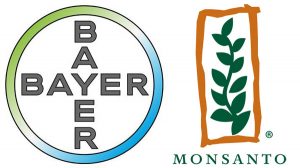 Last month, St. Louis-based agrichemical giant ¬†Monsanto Co. agreed to sell the company ¬†to German pharmaceutical and chemical conglomerate, Bayer, in ¬†an unprecedented $66 billion dollar deal. This takeover of the U.S. firm is the biggest ever by a German company. The combination would create a global agricultural and chemical giant ‚ÄĚ‚ÄĚand bring Bayer together with a leading producer of genetically engineered seeds that are engineered to resist pesticides, particularly Monsanto‚Äôs flagship product, Roundup.
Last month, St. Louis-based agrichemical giant ¬†Monsanto Co. agreed to sell the company ¬†to German pharmaceutical and chemical conglomerate, Bayer, in ¬†an unprecedented $66 billion dollar deal. This takeover of the U.S. firm is the biggest ever by a German company. The combination would create a global agricultural and chemical giant ‚ÄĚ‚ÄĚand bring Bayer together with a leading producer of genetically engineered seeds that are engineered to resist pesticides, particularly Monsanto‚Äôs flagship product, Roundup.
Roundup, whose active ingredient is glyphosate, is used alongside various GE crops including corn and soybeans. In 2015, the World Health Organization‚Äôs International Agency for Research on Cancer (IARC) released a landmark ¬†report naming glyphosate as ¬†‚Äúprobably carcinogenic to humans.‚ÄĚ Glyphosate‚Äôs EU license was set to expire this year, and some member states including France, Sweden, and the Netherlands objected to the renewal. A vote to reauthorize usage of glyphosate on a temporary basis failed in June 2016. However, glyphosate‚Äôs license was extended for 18 months ¬†just as it was about to expire. The next re-evaluation of the license is scheduled at ¬†the end of 2017. In the U.S., the Environmental Protection Agency (EPA) is convening a Scientific Advisory Panel next week to evaluate glyphosate‚Äôs carcinogenic potential, even though the agency is proposing to classify glyphosate as not likely to be carcinogenic.
Bayer CEO Werner Baumann was quoted Monday as telling German daily Sueddeutsche Zeitung: “We don’t want to take over Monsanto in order to establish genetically modified plants in Europe.” He added, “If politics and society in Europe don’t want genetically modified seeds, then we accept that, even if we disagree on the substance.”
This stance not to force GE on Europeans may stem from concerns from Bayer on assuming Monsanto‚Äôs tarnished reputation, which dates back to its production of the Agent Orange defoliant used by U.S. forces in the Vietnam War. According to reports, Bayer had begun discussions about whether to dump the Monsanto name upon the merger’s closing. Bayer is reportedly looking to avoid “sullying its reputation” as it is looking to expand its European operations by building consumer trust. However, Bayer also faces close scrutiny over its own pesticides ‚ÄĒthe neonicotinoids, identified as ¬†contributing to mass die-offs of bees.
The companies say that the takeover will contribute to chemical and agricultural research and eventually will help farmers to produce more food. However, critics express concerns that the merger will only tighten a monopolist grip on markets, and will lead to price increases, lack of availability of non-GE and non-treated seed, increased GE crops, and growing reliance on toxic pesticides.
The merger is not set in stone, however. Several steps  must take place  before the deal can be finalized. Federal regulators would have to give the go-ahead for the deal, as would  the European Commission, which generally opposes the use of GE seeds, an area of specialization for Monsanto. Similarly, chemical giants DuPont and Dow Chemical are also slated to merge, with their boards of directors unanimously  approved the merger of their companies  through an all-stock deal, valuing the combined market capitalization at $130 billion.  In February 2016,  China National Chemical Corp. acquired Syngenta AG, and then cleared a major hurdle to the merger this past August when the Committee on Foreign Investment in the U.S. (CFIUS) gave the  go-ahead  for the merger to move forward, a deal worth nearly $43 million.
Observers say that in the long-term, markets will reveal that relying on the promotion of chemical-intensive agricultural practices is not a sustainable business practice. Chemical-intensive agriculture depends on chemical fertilizers and toxic pesticides that have been shown to ¬†reduce soil organic matter and decrease the diversity of soil biota. These chemical inputs contaminate waterways, leading to eutrophication and ‚Äúdead zones,‚ÄĚ where nothing is able to live or grow. Sustainability advocates say that the ¬†only way that the agricultural industry can create a sustainable business model is to produce products that are compatible with ¬†organic agriculture.
If you oppose the Bayer-Monsanto merger, please consider reaching out to your  Senators  or  Representative  to ask them to reject the approval of a merger that consolidates seed availability, and encourage them instead to focus on increasing the availability of organic seeds, which do not negatively affect  soil, water or human health.
All unattributed positions and opinions in this piece are those of Beyond Pesticides.
Source: RT
Posted in Agriculture, Announcements, Bayer, Chemicals, Corporations, Genetic Engineering, Glyphosate, International, Monsanto by: Beyond Pesticides
No Comments
11
Oct
(Beyond Pesticides, October 11, 2016) Last week, in a calculated attack on the International Agency for Research on Cancer‚Äôs (IARC), the U.S. House of Representatives’ Committee on Oversight and Government Reform summoned the National Institutes of Health (NIH) to answer questions about taxpayer contributions to the World Health Organization‚Äôs (WHO) cancer agency. From reports, it is easy to gather that the committee has problems with IARC scientists‚Äô findings that glyphosate, among other things, is a probable ¬†carcinogen. Led by Chairman Jason Chaffetz (R-UT), the hearing is ¬†clearly aimed at ¬†undermining IARC‚Äôs March 2015 listing of glyphosate as a probable carcinogen based on sufficient evidence of carcinogenicity ¬†found in laboratory studies.
Set to take place in private, limiting any opportunity for public oversight, the hearing will consist of NIH officials answering questions on the scientific processes and public funding from politically-charged committee investigators. If Rep. Chaffetz is persuasive in this rouse against science, he stands to put in jeopardy  a significant amount funding for IARC provided by NIH, a devastating outcome for individuals who value the importance of IARC’s work in the scientific community.
Glyphosate, which is produced and sold as RoundupTM ¬†by Monsanto, has been touted by industry and EPA as a ‚Äúlow toxicity‚ÄĚ chemical, ‚Äúsafer‚ÄĚ than other chemicals. ¬† It is widely used in food production and on lawns, gardens, parks, and children‚Äôs playing fields. However, IARC‚Äôs classification of glyphosate as a Group 2A ‚Äúprobable‚ÄĚ carcinogen revealed to the world that glyphosate is anything but safe. According to IARC‚Äôs 2015 findings, Group 2A means that the chemical is probably carcinogenic to humans based on sufficient evidence of carcinogenicity in experimental animals. The agency considered the findings from an EPA Scientific Advisory Panel report, along with several recent studies in making its conclusion. The agency also noted that glyphosate caused DNA and chromosomal damage in human cells. Further, epidemiologic studies have found that exposure to glyphosate is significantly associated with an increased risk of non-Hodgkin‚Äôs Lymphoma (NHL).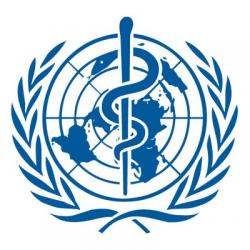
In defending IARC‚Äôs previous findings, IARC director Christopher Wild, Ph.D. rejected Rep. Chaffetz’ criticisms and defended IARC‚Äôs findings, known as ‚Äúmonographs,‚ÄĚ as “widely respected for their scientific rigor, standardized and transparent process and. . .freedom from conflicts of interest.” He also pointed to IARC‚Äôs willingness to adjust these monographs to be consistent with future findings, as they did with coffee, as evidence that IARC is solely concerned with uncovering the truth, not pushing any sort of hidden agenda. Coffee was classified ‚Äúno conclusive evidence for a carcinogenic effect‚ÄĚ after an original listing ¬†as ‚Äúpossibly carcinogenic‚ÄĚ based on a ¬†reevaluation ¬†using additional science. The intentions of IARC‚Äôs scientists are further supported by comments from Aaron Blair, Ph.D., a National Cancer Institute researcher, author of more than 450 publications on occupational and environmental causes of cancer, ¬†and chair of IARC‚Äôs evaluation panel that found ¬†glyphosate (Roundup) to be a carcinogen. Dr. Blair ¬†spoke at Beyond Pesticides 34th National Pesticide Forum. His full remarks on the subject can be viewed here.
Unfortunately, this is not the first time that ¬†the U.S. government has tried to stifle scientific findings in order to its own position or that of the regulated industry. ¬†In 2015, one of the top entomologists at the U.S. Department of Agriculture (USDA) ¬†filed a whistleblower complaint ¬†against a ¬†federal agency, citing unprofessional retaliation following the publication of a ¬†study ¬†linking neonicotinoid insecticides to the decline of monarch butterflies. Jonathan Lundgren, Ph.D., senior research entomologist and lab supervisor for the Agricultural Research Service (ARS) in South Dakota, faced suspension for publishing research deemed ‚Äúsensitive‚ÄĚ by his USDA superior, underscoring why legal protections for government scientists are sorely needed.
A similar attack was waged on Harvard educated biologist and professor of Integrative Biology at the University of California, Berkeley, Tyrone Hayes, ¬†Ph.D. ¬†by the chemical industry. In a study funded by Navartis Agribusiness, Dr. Hayes’ research found that the herbicide atrazine feminizes male frogs and that amphibian species are in decline because of its pervasive use. Dr. Hayes‚Äô work showed that current regulatory reviews allow widespread use of pesticides that cause serious adverse effects well below allowable legal standards and when in mixtures not studied. When Novartis Agribusiness, one of two corporations that would later form Syngenta and the maker of atrazine, found out that Dr. Hayes‚Äô findings contradicted its ¬†expected or desired outcome, Dr. Hayes was criticized by the company, which withdrew its funding. Dr. Hayes continued his research with independent funding and found more of the same results: exposure to doses of atrazine as small as 0.1 parts per billion (below allowed regulatory limits) turns tadpoles into hermaphrodites ‚ÄĒorganisms with both male and female sexual characteristics. When his work appeared in the prestigious Proceedings of the National Academy of Sciences, Sygenta attacked the study, starting an epic feud between the scientist and the corporation. In fact, a June 2013 investigative report by 100Reporters and Environmental Health News exposed the chemical giant‚Äôs multi-million dollar campaign to discredit atrazine critics. This undermining of scientific research led Beyond Pesticides to develop the Fund for Independent Science.
The Fund for Independent Science was developed to act as a mechanism for raising substantial dollars from those who support independent scientific research to inform sound public policy that protects health and the environment. Independent scientists are needed  to understand the toxicology of chemicals that are allowed to be introduced into the environment and the  food supply. This information is critical to influence state and local decision makers to act because of industry-dominated regulatory decisions, such as The U.S. Environmental Protection Agency’s (EPA) Office of Pesticide Programs’ counter determination that glyphosate does not cause cancer. Building systems that are not reliant on toxic inputs requires continual understanding of the destructive capacity of toxic materials in commerce and the sustainable practices that can replace them in the marketplace.
With independent science both in and outside of the U.S., including IARC, pointing to a growing list of impacts from pesticides and genetically engineered (GE) crops, ranging from the ¬†decline of bees ¬†to the carcinogenicity of the widely used herbicide glyphosate, it is critical that federal scientific agencies tasked with protecting human and environmental health be able to inform the public without repercussions from industry groups, which have a vested interest widespread marketing of their toxic products. Additionally, while public oversight can be a positive thing, ¬†Rep. ¬†Chaffetz‚Äô efforts to limit NIH funding for IARC must be viewed in context, with an eye toward his ties to the agrichemical industry. For more information, see Public Employees for Environmental Responsibility’s (PEER) ¬†pattern of science manipulation at USDA. To see the history of industry influence in federal agencies, visit ¬†this link ¬†to our Daily News Blog.
All unattributed positions and opinions in this piece are those of Beyond Pesticides.
Source: Reuters
Posted in Announcements, Cancer, Chemicals, Corporations, Disease/Health Effects, Glyphosate, Monsanto, National Politics, Pesticide Regulation by: Beyond Pesticides
No Comments
07
Oct
(Beyond Pesticides, October 7, 2016) For the first time in U.S. history, the U.S. Fish and Wildlife Service (FWS) has added a group of bees to the list of Endangered Species. FWS published a final rule last Friday that  declares seven species of yellow-faced bees (genus Hylaeus) that are native to Hawaii as endangered. This announcement immediately follows last week’s news that FWS has proposed listing the rusty patched bumble bee as an endangered species under the Endangered Species Act (ESA).
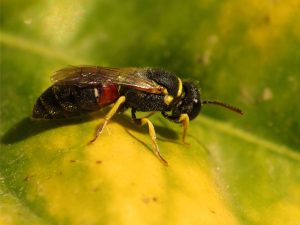 While the decision is great news for these bees and the environmental groups who have fought to protect them, there is still much work that needs to be done, and FWS says that it needs additional time to identify specific areas to be designated as critical habitat for the endangered bees. Further, though FWS has identified many threats to bees, including habitat loss and degradation due to urbanization, and other human activities, the final rule does not specifically point to pesticides. However, there is an overwhelming amount of research demonstrating that neonicotinoid insecticides, working either individually or synergistically, play a critical role in the ongoing decline of bees and other pollinators.
While the decision is great news for these bees and the environmental groups who have fought to protect them, there is still much work that needs to be done, and FWS says that it needs additional time to identify specific areas to be designated as critical habitat for the endangered bees. Further, though FWS has identified many threats to bees, including habitat loss and degradation due to urbanization, and other human activities, the final rule does not specifically point to pesticides. However, there is an overwhelming amount of research demonstrating that neonicotinoid insecticides, working either individually or synergistically, play a critical role in the ongoing decline of bees and other pollinators.
Neonicotinoids have been linked to a range of both acute and chronic effects on pollinators. Studies have found the insecticides can adversely affect reproduction, impair pollination, and alter behavior. Once these chemicals are used in the environment, their persistence and long half-life means that they remain a problem for beekeepers well into the future.
This final rules comes one year to the day since the proposed rule was published, and following a multi-year effort by the Xerces Society, which  submitted petitions to FWS in March 2009, to gain recognition and protection for these bees. According to Xerces, these bees are often found in small patches of habitat connected by agricultural land or developments. There is only one genus of bees that is native to the Hawaiian Islands, Hylaeus, commonly called yellow-faced bees because of colored markings on their faces.
These bees are often found in small patches of habitat hemmed in by agricultural land or developments. This is particularly troubling as Hawaii’s year-round growing conditions have made it a prime target for agrichemical companies to test new, experimental forms of genetically engineered (GE) crops, which brings with it increased pesticide use. Data released last year reveals that  high levels of restricted use pesticides, in some cases almost double the pounds per acre average of other states, are being used in Kauai County. A May 2014 report  found 25 herbicides, 11 insecticides and 6 fungicides in Hawaii’s waterways, underscoring concerns for ecological health. Further, a study published earlier this year found that even when attempting to protect pollinators by planting pollinator habitat and hedgerows around conventional farms, neonicotinoids used onsite can make their way into flowering crops in field margins, putting pollinators in danger.
For these reasons and many others, Beyond Pesticides works to promote the widespread transition of conventional farmland to organic production. With one in three bites of food reliant on pollination from bees,  other insects, and birds, the decline in pollinators due to pesticides, and other human-made causes, demands immediate action. For help on how you can get involved to reverse pollinator declines, see Beyond Pesticides’ Bee Protective webpage. And for more information on why organic is the right path for the future of agriculture, see Beyond Pesticides Organic Agriculture program page.
Sources: FWS, Xerces
All unattributed positions and opinions in this piece are those of Beyond Pesticides.
Posted in Alternatives/Organics, Announcements, Increased Vulnerability to Diseases from Chemical Exposure, Pollinators, Wildlife/Endangered Sp. by: Beyond Pesticides
No Comments
06
Oct
(Beyond Pesticides, October 6, 2016) According to a report published last week by the Iowa Environmental Council (IEC), the associations between elevated levels of nitrate in drinking water and health risks go well beyond the ‚Äúblue-baby syndrome‚ÄĚ and nitrate concentrations lower than the drinking water standard may be harmful through long-term exposure. The lead author of the report, Ann Robinson, Agricultural Policy Specialist at IEC, stated that the focus was on ‚Äúsignificant findings that multiple studies have associated with nitrate in drinking water, including birth defects, bladder cancer and thyroid cancer.‚ÄĚ ¬†Nitrate is a common groundwater contaminant that is sourced mainly from chemical fertilizers and animal waste.
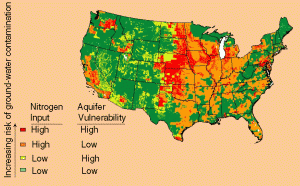 Nitrate is a common contaminant of drinking water, particularly in agricultural areas where nitrogen fertilizers are used. In 1962, the U.S. Environmental Protection Agency (EPA) established the drinking water standard of 10 mg/L of nitrate to prevent blue baby syndrome, a fatal infant blood disease. In addition to Iowa, the U.S. Geological Survey has also identified the following states as areas with high risk clusters from nitrate contamination to groundwater: Oklahoma, Kansas, Nebraska, North and South Dakota, Illinois, Minnesota, Pennsylvania, and Maryland.
Nitrate is a common contaminant of drinking water, particularly in agricultural areas where nitrogen fertilizers are used. In 1962, the U.S. Environmental Protection Agency (EPA) established the drinking water standard of 10 mg/L of nitrate to prevent blue baby syndrome, a fatal infant blood disease. In addition to Iowa, the U.S. Geological Survey has also identified the following states as areas with high risk clusters from nitrate contamination to groundwater: Oklahoma, Kansas, Nebraska, North and South Dakota, Illinois, Minnesota, Pennsylvania, and Maryland.
The report reviewed studies conducted in the U.S., Canada, and Australia that found statistically significant associations between elevated levels of nitrate in drinking water and birth defects including neural tube defects such as spina bifida, oral cleft defects, limb deficiencies, and other skeletal system deformities. Studies conducted in Iowa, Spain, Germany, and Taiwan all reported similar increased risk for bladder cancer when nitrate concentrations in drinking water increased. And finally, two large long-term studies conducted by the National Cancer Institute and the National Institutes of Health concluded that there was an increased risk for thyroid cancer with increased intake of nitrate through drinking water and other sources.
Ann Robinson said in a statement that, ‚ÄúWhile more research is needed, the current findings offer compelling reasons to accelerate efforts to reduce pollution from nitrate flowing into our surface and ground water from farm fields, urban yards, livestock facilities, water treatment plants and other sources.‚ÄĚ High rates of fertilizer application may also increase the natural nitrate levels found in certain vegetables, such as lettuce and root crops. Prior research has indicated that long-term exposure to nitrates through food and water may increase the risk of thyroid disease. In the body, nitrate competes with uptake of iodide by the thyroid, thus potentially affecting thyroid function.
Iowa has been at the center of a growing debate about synthetic fertilizer use and the harmful effects caused by high nitrate levels in drinking water systems. This heavily agricultural state relies on a tile drainage system running under millions of acres of land that initially transformed the swampy land into highly productive farmland. This tile system is extremely problematic when it comes to non-point source pollution from nitrates, which leach into Iowa‚Äôs waterways by way of the drainage pipes. This issue has received heightened attention following the Des Moines Water Works lawsuit against three drainage districts in northwest Iowa over the high nitrate levels in the city‚Äôs water supply. Additionally, Iowa is a leading contributor to the nutrient pollution from nitrogen and phosphorus that contributes to the large ‚Äúdead zone‚ÄĚ in the Gulf of Mexico.
State and federal officials must address the root of the problem‚ÄĚ‚ÄĚincluding the extreme levels of nutrient buildup and the dangerous amount of nitrogen and phosphorus found in the water, caused by excess fertilization runoff from both chemically-intensive agricultural and residential sources. Drinking water treatment, which has been advocated for by some, is a short-term, band-aid option to a problem that is persistent and must be addressed through preventive, long-term solutions. Beyond Pesticides has long supported ‚Äúfeed-the-soil‚ÄĚ approaches to all types of landscape management. Understanding the role of healthy soils in creating healthy landscapes and plants, Beyond Pesticides promotes a systems approach that centers on management of soil health and proper fertilization that eliminates synthetic fertilizers and focuses on building the soil food web and nurturing soil microorganisms.
Organic farming and land management uses natural, less soluble sources of nitrogen, phosphorous and magnesium; including cover crops, compost, manure and mineralized rock, in order to promote increases in soil organic matter and a healthy soil structure. Healthy soil structure allows water to infiltrate the ground slowly, rather than escaping across the surface and carrying soil particles, nutrients, and other inputs with it. Also, it allows plants to establish vibrant root systems that resist erosion. For more details, see Beyond Pesticides fact sheet  Organic Land Management and the Protection of Water Quality.
Source: Iowa Environmental Council, TakePart
All unattributed positions and opinions in this piece are those of Beyond Pesticides.
Posted in Agriculture, Alternatives/Organics, Announcements, Birth defects, Cancer, Disease/Health Effects, Iowa, Pesticide Residues, State/Local, Thyroid Disease, Water by: Beyond Pesticides
2 Comments
05
Oct
(Beyond Pesticides, October 4, 2016) Last week, the ¬†Oregon Liquor Control Commission (OLCC) approved 26 licences for 26 recreational marijuana retailers as well as modified state rules regarding state licensure testing requirements and packaging limitations. According to a OLCC press release, some of the marijuana retailers began operating on October 1st, fulfilling the OLCC’s promise to Oregon‚Äôs citizens that recreational marijuana stores would be open for business in fall 2016.
 OAR 845-025-5700 previously required that all batches be tested for pesticides. Under the new Oregon Administrative Rules (OAR) Temporary Pesticide Rules (‚ÄúLimited Batch Testing‚ÄĚ) OAR 845-025-5700, effective September 30, 2016 until March 1, 2017, the OLCC requires a minimum of 33.3% of batches per harvest lot of cannabis to be tested. According to OAR 333-007-0010, if the OLCC finds that there is not enough laboratory capacity for pesticide testing, the Commission may permit randomly chosen samples from batches of usable marijuana to be tested for pesticides by a licensed lab, rather than requiring every batch of usable marijuana from a harvest lot to be tested. If any part of those samples fails pesticide testing, every 10-pound lot is required to be tested. If the samples that are tested all passed, the entire harvest lot is considered ‚Äúpassed,‚ÄĚ and may be transferred or sold.
OAR 845-025-5700 previously required that all batches be tested for pesticides. Under the new Oregon Administrative Rules (OAR) Temporary Pesticide Rules (‚ÄúLimited Batch Testing‚ÄĚ) OAR 845-025-5700, effective September 30, 2016 until March 1, 2017, the OLCC requires a minimum of 33.3% of batches per harvest lot of cannabis to be tested. According to OAR 333-007-0010, if the OLCC finds that there is not enough laboratory capacity for pesticide testing, the Commission may permit randomly chosen samples from batches of usable marijuana to be tested for pesticides by a licensed lab, rather than requiring every batch of usable marijuana from a harvest lot to be tested. If any part of those samples fails pesticide testing, every 10-pound lot is required to be tested. If the samples that are tested all passed, the entire harvest lot is considered ‚Äúpassed,‚ÄĚ and may be transferred or sold.
Oregon Governor Kate Brown said in a news release on September 30, ‚ÄúBased on what we have learned from the nationwide legalization effort, it is more important than ever to ensure certain products that make it to shelves are free from pesticides and contaminants.”
In July, the Oregon Department of Agriculture (ODA), in an effort to curb the use of illegal pesticides in cannabis production, issued 12 notices of statewide detainment and stop sale and removal orders for horticultural pesticide products that contain active ingredients not listed on the label. This raised serious public health, statutory, and regulatory compliance concerns, pushing ODA to make pesticide testing more of a priority. Oregon’s guide list for pesticide products allowed for use in the production of cannabis contains 313 pesticide products, and aligns with similar product lists published by Washington State and Colorado. This list raises concerns over the lack of health evaluations of public exposure to the pesticides used. The list construes broad label language to allow the use of pesticide products that have not been specifically tested for use on marijuana, despite the fact that the EPA has not registered or reviewed any pesticide product for use on cannabis. For example, one ingredient approved through these standards that raises a red flag when it comes to human health and safety is the synergist piperonyl butoxide (PBO), which is often mixed with pesticides to increase their potency.
The Oregon Health Authority (OHA) and OLCC decided not to change the packaging and labeling standards for new products, yet instead allow licensees who do not have pre-approved packaging and labels to use generic packaging and labeling until their packaging is approved by the OLCC. The OLCC did, however, pass a temporary rule that prohibits wording that is deemed ‚Äúattractive to minors,‚ÄĚ as defined in OAR 845-025-7000(1).
In early September, King County in Washington State, proposed creating their own program that would test marijuana for prohibited pesticides. In the absence of state and federal testing programs to keep consumers safe, King County stands to be the first local jurisdiction to take protecting marijuana consumers from the potential harms of toxic chemicals into their own hands.
In Washington State, it took nearly two years after the first legal retail sales of marijuana before the state Liquor and Cannabis Board (LCB) finally took action to protect the rights of consumers by strengthening its ability to issue product recalls when there is a risk to health and safety. The move by Washington followed widespread cannabis recalls in the City of Denver, and actions from Colorado‚Äôs Governor to declare pesticide-tainted cannabis ‚Äúa threat to public safety,‚ÄĚ highlighting the ongoing struggle of states to regulate marijuana despite its federal status as a Schedule I drug.
Beyond Pesticides is urging states to prohibit registered pesticides in cannabis production, given the lack of testing for increased exposure through inhalation, ingestion, and skin absorption. Beyond Pesticides supports criteria that limits allowed pesticides to those that are exempt from registration under federal pesticide law and also permitted for use in organic production, as long as they do not have a tolerance established by the Environmental Protection Agency (EPA). As outlined in a letter sent from Beyond Pesticides to Washington State Department of Agriculture (WSDA) officials, adhering exclusively to pesticides allowed under 25(b) [Federal Insecticide, Fungicide and Rodenticide Act (FIFRA)] is the best way to avoid any legal ramifications for unregistered pesticide use, as well as protect workers, consumers and the environment safe from the unstudied side effects that may result from the use of toxic pesticides on marijuana crops. With this approach, Beyond Pesticides urges growers to develop an organic system plan that encourages pest prevention, and eliminating pest-conducive conditions. Implementing this approach, advocates say, will ensure the sustained growth of cannabis production that protects public health and the environment.
For more information and background on this important issue, see Beyond Pesticides’ report: Pesticide Use in Marijuana Production: Safety Issues and Sustainable Options.
All unattributed positions and opinions in this piece are those of Beyond Pesticides.
Source: Cannabis Business Times, Oregon Live
Posted in Announcements, Cannabis, Oregon, State/Local by: Beyond Pesticides
No Comments
04
Oct
(Beyond Pesticides, October 4, 2016) Chemicals previously used as ¬†inert ingredients in pesticide formulations have been detected in a wide range of North American wildlife species, according to research published in the journal Environmental Science and Technology. The compounds, perfluroalkyl phosphinic acids (PFPIAs), were widely used as anti-foaming agents in pesticide formulations until 2006, when the U.S. Environmental Protection Agency took regulatory action to cancel ¬†their use, citing ‚Äúhuman health and environmental risks of concern.‚ÄĚ However, the chemicals continue to be used today in consumer goods, including carpet cleaning formulas.
 While scientists did not find what they would consider high concentrations of the chemicals in wildlife, the ubiquity of the detections was found to be most concerning. Researchers detected the presence of PFPIAs in the blood of 100% of animals sampled. This includes northern pike in Montreal, Canada, cormorants from the Great Lakes, and bottlenose dolphins from Sarasota Bay, Florida. “We aimed for diversity: air-breathing versus water-breathing, differences in habitat, different taxonomic groups,” Amila O. De Silva, PhD, coauthor of the study, said to CNN. Part of the reason for the wide range of detection lies with the properties of these chemicals. They are highly stable and resist degradation from exposure to water or sunlight, or breakdown by microbes. Dr. De Silva indicated to CNN that the usual ways that the environment remediates chemicals ‚Äúdon‚Äôt seem to apply‚ÄĚ to PFPIAs.
While scientists did not find what they would consider high concentrations of the chemicals in wildlife, the ubiquity of the detections was found to be most concerning. Researchers detected the presence of PFPIAs in the blood of 100% of animals sampled. This includes northern pike in Montreal, Canada, cormorants from the Great Lakes, and bottlenose dolphins from Sarasota Bay, Florida. “We aimed for diversity: air-breathing versus water-breathing, differences in habitat, different taxonomic groups,” Amila O. De Silva, PhD, coauthor of the study, said to CNN. Part of the reason for the wide range of detection lies with the properties of these chemicals. They are highly stable and resist degradation from exposure to water or sunlight, or breakdown by microbes. Dr. De Silva indicated to CNN that the usual ways that the environment remediates chemicals ‚Äúdon‚Äôt seem to apply‚ÄĚ to PFPIAs.
“Previous work by other scientists in three separate publications have shown perfluorophosphinic acids are found in human blood samples from North America and Germany,” Dr. De Silva continued to CNN. Dr. De Silva‚Äôs previous research detected the presence of PFPIAs in 83% of household dust samples from homes sampled in Toronto, Canada.
The widespread presence of these little known persistent organic pollutants is cause for concern for regulators and the public. While limited research has been conducted to look for these compounds, even less is known about its toxicity and effects on humans, wildlife, or the wider environment. In EPA‚Äôs 2006 determination to remove these chemicals from pesticide products, the agency stated, ‚ÄúThe very limited information available to the Agency indicates that there may be serious human health and environmental risk issues associated with these compounds.‚ÄĚ
Despite the widespread presence of these chemicals and concern among U.S. regulators, these compounds have likely been used in pesticide formulations since the 1970s, according to Zhanyun Wang, PhD, a German scientist and expert on perfluroalkyl chemicals interviewed by CNN. This information is difficult to uncover however, because manufacturers are not required to disclose data on inert ingredients in pesticide products, despite the fact that they may be more toxic than the active ingredient in a pesticide or create hazardous synergistic interactions between it and the active ingredient or other inert ingredients.
In 2006, Beyond Pesticides and allies petitioned EPA to require manufacturers to disclose inert ingredients in pesticide product formulations. In 2009, the agency responded and took steps toward inert ingredient disclosure, publishing a proposed rule in the federal register. However, the agency took no action after proposing the rule. In 2014, the coalition filed an ‚Äúundue delay‚ÄĚ complaint against EPA, but was met with resistance. EPA backtracked on its original intent to require disclosure, and the lawsuit was thrown out because the agency indicated it would no longer issue rulemaking.
The agency instead released a list of 72 inert ingredients it had already discontinued from use in pesticide formulations. The proposal failed to address the issue of disclosure for 300 other inert ingredients allowed in pesticide formulations, but did indicate the past use of hazardous compounds, such as rotenone, turpentine oil, and cresol.
In response to this insufficient action, Beyond Pesticides and allies sued the agency again, charging that EPA‚Äôs current allowance for voluntary disclosure of inert ingredients does not protect the public or the environment. However, a federal court ruling handed down this past June stated that, ‚ÄúThe EPA has no mandatory duty to require disclosure of ‚Äúinert‚ÄĚ ingredients in pesticides, even if those ingredients qualify as hazardous chemicals under separate statutes.‚ÄĚ
Consumers are becoming increasingly wary of products with toxic ingredients, driving a huge shift towards ‚ÄĚňúgreener‚Äô technologies. More and more consumers are choosing least-toxic product alternatives for pest management that are exempt from federal pesticide registration and considered minimum risk by EPA. With these products, all ingredients, including inerts, must be disclosed. ¬†This, coupled with a growing organic market, offers opportunities and challenges for formulators to develop and market least-toxic products with minimum risk pesticides that may be compatible with low hazard standards, such as organic, and consumer expectations.
Source: CNN, Environmental Science and Technology
All unattributed positions and opinions in this piece are those of Beyond Pesticides.
Posted in Biomonitoring, Chemicals, Environmental Justice, International, Pesticide Residues, Uncategorized, Water, Wildlife/Endangered Sp. by: Beyond Pesticides
1 Comment
03
Oct
(Beyond Pesticides, October 3, 2016) On Friday, the California Department of Pesticide Regulation (CDPR) released a rule titled, Pesticide Use Near Schoolsites, that proposes limited restrictions for certain agricultural pesticide applications near schools and child day care facilities. CDPR, whose proposal  has been criticized by advocates as not adequately protective of workers and communities, is accepting public comments on the proposal until November 17, 2016.
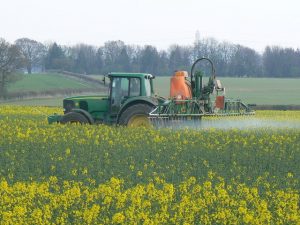 The ¬†proposed rule, effective October 1, 2017, will require farmers to notify public schools and child day care facilities when ‚Äúcertain pesticide applications made for the production of an agricultural commodity near a school site are planned in the coming year and also a few days prior to the applications.‚ÄĚ For pesticides applied via aircraft, airblast sprayer, sprinkler chemigation, and fumigation, there must be a minimum ¬ľ ¬†mile buffer around the school or child day care facility. While the move by CDPR is a step in the right direction, it is not rigorous enough and does not adequately protect the most vulnerable populations from pesticide exposure, according to advocates. The rule does not include private K-12 schools or family day care homes, a move that according to CDPR documents is due to the potential for increased costs to businesses and regulated entities. Additionally, the rule only applies to pesticide application activities Monday through Friday, during the hours of 6am to 6pm. Advocates say that these are unacceptable holes in this proposed rule and must be addressed before the final rule is published.
The ¬†proposed rule, effective October 1, 2017, will require farmers to notify public schools and child day care facilities when ‚Äúcertain pesticide applications made for the production of an agricultural commodity near a school site are planned in the coming year and also a few days prior to the applications.‚ÄĚ For pesticides applied via aircraft, airblast sprayer, sprinkler chemigation, and fumigation, there must be a minimum ¬ľ ¬†mile buffer around the school or child day care facility. While the move by CDPR is a step in the right direction, it is not rigorous enough and does not adequately protect the most vulnerable populations from pesticide exposure, according to advocates. The rule does not include private K-12 schools or family day care homes, a move that according to CDPR documents is due to the potential for increased costs to businesses and regulated entities. Additionally, the rule only applies to pesticide application activities Monday through Friday, during the hours of 6am to 6pm. Advocates say that these are unacceptable holes in this proposed rule and must be addressed before the final rule is published.
California officials told the Associated Press that ‚Äúroughly 34 people were sickened in five instances throughout the state between 2005 and 2014 when pesticides drifted onto campuses, demonstrating a need for stricter regulations.‚ÄĚ The rule will cover 3,500 schools and day cares and affect approximately 2,500 growers in California.
The stakes are high for families living in the Central Valley of California, where agricultural pesticide use is widespread. According to a 2014 report by the California Department of Public Health, Fresno, Tulare, and San Joaquin counties having the highest numbers of schools within ¬ľ mile of pesticide application. Additionally, of the top 10 pesticides applied within ¬ľ mile of the schools assessed, 6 are restricted use and all have been associated with at least one negative effect on children‚Äôs health, including cancer, endocrine disruption, developmental delays, and neurotoxicity. California schools began implementing new pesticide reporting and use requirements at the beginning of 2015. All schools and child day care centers statewide are now required to report their annual use of pesticides to CDPR.
While the new limits and restrictions are a step in the right direction, farmworker and advocacy groups believe that more needs to be done, as they fall short of scientists‚Äô recommendations. Increased buffer zones may provide some reprieve from pesticide trespass, but it will not eliminate health concerns for children in the region. Virginia Zaunbrecher, JD, of UCLA‚Äôs Science and Technology program remarked to Fresno Bee earlier this year, ‚ÄúIn general, a buffer zone is going to decrease exposure, but it‚Äôs not going to eliminate exposure.‚ÄĚ Beyond Pesticides has long encouraged a minimum two mile buffer zone for agricultural pesticide use around sensitive areas. The proposed rule does create a route of communication and notification for when pesticide applications will be taking place, which is an important component for communities.
More than a decade ago, six families filed a civil rights complaint with the U.S. Environmental Protection Agency (EPA) that details the dangerous levels of pesticides at Latino public schools throughout California that exposed Latino kids to chemicals linked to cancer, birth defects, neurodevelopmental disorders and other serious health problems. The complaint urged EPA to enforce the Title VI of the Civil Rights Act, which prohibits recipients of federal funds from engaging in discriminatory practices. In 2011, as a result of a settlement agreement EPA reached with CDPR, EPA found that CDPR’s past renewal of the toxic fumigant methyl bromide discriminated against Latino school children whose schools are located near agriculture fields, conceding that unintentional adverse and disproportionate impact on Latino children resulting from the use of methyl bromide during that period could have occurred. Little was done to remedy these exposures and so a lawsuit was filed in 2013 against EPA’s continuing failure to protect Latino students. The case was subsequently moved for dismissal in federal court in part due to lack of jurisdiction. Methyl bromide is still widely used in California to grow strawberries, despite its ban under the Montreal Protocol, but it will no longer be eligible for a critical use exemption after 2016.
Ultimately, what is needed to truly protect community health is a transition away from toxic pesticides toward agricultural practices which promote pest resilience and eliminate  the need for toxic chemicals. A wide variety of alternative practices and products are available to assist growers in preventing pest problems before they start. Organic agriculture, which requires farmers to improve soil health and craft an organic system plan to guide pest control decisions, represents a viable path forward for agriculture in California and beyond.
Any interested person may present comments in writing about the proposed action by the CDPR to the agency contact, Linda Irokawa-Otani. Written comments must be received no later than 5:00 p.m. on November 17, 2016. Comments regarding this proposed action may also be transmitted via e√ĘňÜ‚Äômail to [email protected] or by fax to 916√ĘňÜ‚Äô324√ĘňÜ‚Äô1491.
All unattributed positions and opinions in this piece are those of Beyond Pesticides.
Source: Associated Press
Posted in Alternatives/Organics, Announcements, Aquaculture, California, Children/Schools, Environmental Justice, Farmworkers, Pesticide Drift, Pesticide Regulation, Uncategorized by: Beyond Pesticides
1 Comment
30
Sep
(Beyond Pesticides, September 30, 2016) Stand up for organic! The public comment period has opened on the National Organic Standards Board (NOSB) proposed recommendations affecting  organic standards, materials and policy. The fall 2016 meeting dates have been announced and public comments are due by October 26, 2016. Your comments and participation are critical to the integrity of the organic label. Make your voice heard before the comment period closes. We’ve made tremendous progress in creating an organic food production system. Let’s not let USDA turn back the clock.
 Beyond Pesticides has  begun to analyze the numerous recommendations and are providing you  with our positions that we hope you will use as the basis for your comments. We will provide positions on additional topics in the near future. Please feel free to develop your own comments or cut and paste ours. If you cut and paste our comments into regulations.gov, please first put a personal note of concern in order to reflect the importance if these issues to you as an organic consumer, farmer or other concerned party.
Beyond Pesticides has  begun to analyze the numerous recommendations and are providing you  with our positions that we hope you will use as the basis for your comments. We will provide positions on additional topics in the near future. Please feel free to develop your own comments or cut and paste ours. If you cut and paste our comments into regulations.gov, please first put a personal note of concern in order to reflect the importance if these issues to you as an organic consumer, farmer or other concerned party.
Some of the major issues before the fall 2016 National Organic Standards Board include:
- Chlorine Dioxide Gas: Beyond Pesticides is appalled that the NOSB Handling Subcommittee (HS) would propose adding chlorine dioxide gas to the National List and we maintain that the petition should be rejected because it fails to meet all Organic Foods Production Act (OFPA) criteria. The petitioned product has a conditional registration from the Environmental Protection Agneyc (EPA), meaning that not all essential data have been submitted. It is not labeled for this use. The necessary tolerances or exemptions from tolerances do not exist. It is a hazardous chemical used to take the place of care in handling and less hazardous materials. Because the petitioner created confusion around the petitioned substance, important information about the hazards of chlorine dioxide gas and its regulation by EPA were hidden from the HS in its deliberations. The NOSB should not approve more sanitizers ‚ÄĒparticularly chlorine-based sanitizers‚ÄĚ‚ÄĚuntil performing a comprehensive review of sanitizers’ adverse effects to health and the environment and their need (essentiality) in organic production.
- Carrageenan: Beyond Pesticides opposes the relisting of carrageenan on ¬ß205.605(a) and believes that the substance should be removed from the National List. Carrageenan should be reclassified as a synthetic. The NOSB must take a precautionary approach when assessing the studies that refute findings of health effects as they were performed by the same group of industry-supported scientists. Even giving equal weight to industry-supported and independent research, the NOSB must accept the existence of science pointing to serious health consequences associated with the consumption of carrageenan and act to protect organic consumers. The evidence summarized by the 2015 Technical Review came up with a verdict of mixed results on virtually every issue regarding food grade (high molecular weight) carrageenan. However, there is widespread agreement that poligeenan, which contaminates food grade carrageenan at unknown and uncontrollable levels, does cause adverse effects, including cancer. The production causes adverse environmental impacts. And it is not necessary ‚ÄĒorganic processors have been moving away from the use of carrageen because of consumer pressure since it was last considered for sunset.
- Hydroponics: Beyond Pesticides supports the view of the majority of the Crops Subcommittee to recommend that hydroponics, aeroponics, bioponics and aquaponics methods should not be considered eligible for organic certification. Organic production depends upon the ‚ÄúLaw of Return,‚ÄĚ which together with the rule ‚ÄúFeed the soil, not the plant,‚ÄĚ and the promotion of biodiversity, provide the ecological basis for organic systems. Hydroponic/aeroponic/bioponic/aquaponics systems are not consistent with these principles in organic production. Somewhere along the continuum between in-ground production and bioponics is a line separating those methods of production that can be certified organic from those that cannot. We can say that the line is somewhere along that continuum ‚ÄĒin-ground production can be certified organic, while hydroponics/aeroponics/bioponics/aquaponics cannot.
- EPA List 3 ‚ÄĒ Inerts of Unknown Toxicity: The NOSB must take the sunset review of List 3 ‚Äúinerts‚ÄĚ seriously. Although List 3 ‚Äúinerts‚ÄĚ are included in the annotation change approved at the fall 2015 NOSB meeting, it may be several years before that annotation takes effect. The NOSB has identified the three List 3 ‚Äúinerts‚ÄĚ in use in organic production, and should review them according to OFPA criteria as required by law rather than simply waiting for the annotation change to take effect. The former ‚ÄúList 3 inerts,‚ÄĚ which were approved for use only in passive pheromone dispensers, have received special treatment ‚ÄĒthe law did not intend for ‚Äúinerts‚ÄĚ on List 3 to be allowed in organic production. The definition of ‚Äúpassive polymeric dispenser products‚ÄĚ that was included in the spring 2012 NOSB recommendation was refused by the National Organic Program NOP. Therefore, this small group of chemicals has questionable status. From Beyond Pesticides’review of these chemicals, we think it quite likely that at least some will be found to be acceptable when reviewed by the NOSB, but the existence of such an exceptional listing does not support the integrity.
Please go to Beyond Pesticides’ Keeping Organic Strong webpage to learn more about these and other substantive issues, and to provide a unique public comment to the NOSB.
We ask that you submit comments on as many issues and materials as you can by the October 26 deadline. For help crafting your comments, view Beyond Pesticides’ commenting guide.
Thank you for helping to protect and uphold organic integrity!
All unattributed positions and opinions in this piece are those of Beyond Pesticides.
Posted in Agriculture, Alternatives/Organics, Announcements, National Organic Standards Board/National Organic Program, National Politics, Take Action, Uncategorized by: Beyond Pesticides
3 Comments
29
Sep
(Beyond Pesticides, September 29, 2016) A study released last week shows that Miami-Dade County’s aerial spraying of naled for Zika virus produced little reduction on the female Aedes aegypti populations throughout the area. According to the study, Efficacy of Aedes aegypti population control methods in the first two mosquito-borne Zika transmission zones in Miami-Dade County, Florida, within three days of spraying, the mosquito population were virtually identical to the pre-spray levels. The author, Philip Stoddard, Ph.D., is a biology professer at Florida International University and mayor of South Miami.
‚ÄúApplication of permethrin, a persistent pyrethroid adulticide, had no effect whatsoever on mosquito counts. Naled, a potent organophosphate adulticide applied aerially, produced a transitory suppression in Wynwood but lost efficacy after two or three applications,” said Dr. Stoddard. “In Miami Beach, aerial ¬†application of naled produced no significant reduction of the Aedes aegypti population.‚ÄĚ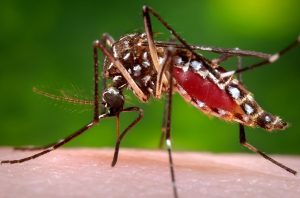
Naled is an organophosphate insecticide with the highest acute toxicity of any mosquitocide. According to the U.S. Environmental Protection Agency (EPA), naled can cause cholinesterase (an enzyme necessary to the transmission of nerve impulses) inhibition in humans, meaning that it can overstimulate the nervous system, causing nausea, dizziness, confusion, and, at very high exposures (e.g., accidents or major spills), respiratory paralysis and death. Local residents throughout Miami-Dade have repeatedly expressed their concerns about the county’s use of toxic chemicals to combat Zika, worried especially about the health of their children. Dr. Stoddard’s study puts further emphasis on how rushing to use ineffective pesticide spraying to solve Zika problems exposes both humans and wildlife  to unnecessary danger.
Earlier this month, Beyond Pesticides wrote a letter to the EPA, urging the agency to alert local and state officials to the fact that key data reviews on the safety of widely used mosquito control pesticides, including naled and synthetic pyrethroids, are outdated and incomplete. According to EPA documents, the agency did not meet a planned 2015 deadline for a final review decision evaluating residential exposure to naled, and its highly toxic breakdown product dichlorvos [DDVP]. In addition to the toxic properties of naled, EPA has stated in review documents that it ‚Äúhas determined that the adverse effects caused by DDVP that are of primary concern to human health are neurological effects related to inhibition of cholinesterase activity.‚ÄĚ
Many researchers question the efficacy of spray programs for adult mosquitoes, especially given the biology of the targeted mosquito, Aedes aegypti. This mosquito stays close to its breeding sites in residential areas and inside homes, suggesting that community spray programs are the least effective control measure. Harvard Medical School Scientist and Zika expert, Michael Callahan, Ph.D., believes that aerial spraying could potentially make the Zika problem worse by killing natural predators of the Aedes aegypti mosquitoes. Dr. Callahan stated in a video interview:
‚ÄúWe can tell you what hasn‚Äôt worked in the past with aerial spraying with this mosquito. There‚Äôs been a lot of money wasted in Singapore, Taiwan and Japan and several Central American countries, trying to control aedes aegypti with aerial spraying. It does not work. It is an indoor resident. About 60-70 of our total community population is indoors and it is not flying around at night when the aerial spraying controls. What you see in Florida is the adaptive plan for West Nile mosquito… Aerial spraying with naled or many of the other insecticides have been proven systematically to be less effective. For Aedes aegypti you need on the ground spray, houses and yards and absolutely control breeding sites by getting rid of standing water.‚ÄĚ
The underlying philosophy of mosquito control is based on the fact that the greatest control impact on mosquito populations will occur when they are concentrated, immobile and accessible. This position is reflected in the Joint Statement on Mosquito Control in the United States from the U.S. Environmental Protection Agency (EPA) and the U.S. Centers for Disease Control and Prevention (CDC)  (September 2012).    The most effective strategy emphasizes habitast management and controlling the immature stages before the mosquitoes emerge as adults.    
CDC said in 2001, ‚ÄúAdulticiding, the application of chemicals to kill adult mosquitoes by ground or aerial applications, is usually the least efficient mosquito control technique.‚ÄĚ ¬†See also page 15, section VI, of Beyond Pesticides’ ¬†Public Health Mosquito Management Strategy.
In light of the identified hazards and unknown effects of exposure to naled and synthetic pyrethroids, Beyond Pesticides urges local and state officials to consider more closely the lack of efficacy associated with massive spray programs. Beyond Pesticides encourages an integrated approach to mosquito management that focuses on prevention through public education encouraging frequent removal of standing water, larviciding, and use of repellents. If prevention measures are enforced, the need to spray should be extremely limited, and balanced against the potential public health impacts of hazardous pesticides.  Community based programs should encourage residents to employ these effective techniques, focus on eliminating breeding sites on public lands, and promote monitoring and action levels in order to determine what, where, and when control measures might be needed.  Consider contacting Beyond Pesticides for 25 free mosquito doorknob hangers to encourage best management practices in your neighborhood.
Dr. Stoddard spoke at the 33rd National Pesticide Forum in Orlando, Florida. He  spearheaded an initiative to address mosquito-borne diseases while limiting environmental damage from over-application of broad-spectrum insecticides, designating the city of South Miami as a wildlife sanctuary in order to prevent mosquito spray by the county. Learn more by watching his talk here.
Sources: Miami New Times, Miami Herald
All unattributed positions and opinions in this piece are those of Beyond Pesticides.
Posted in Uncategorized by: Beyond Pesticides
No Comments
28
Sep
(Beyond Pesticides September 28, 2016) This summer, Beyond Pesticides teamed up with The Bees Waggle to develop pollinator curriculum with the intent of making it widely available for public use. The goal of the curriculum is to provide a fun, hands-on lesson about pollinators and their importance to food production. Through the lesson, students learn about biodiversity, soil health, and the negative effects of pesticides on pollinators, while participating in a variety of activities on these issues. In addition, Beyond Pesticides  will offer small grant opportunities for teachers in school districts that serve low-income students in order to offset the cost of materials and supplies required to conduct the pollinator lesson plan.
The launch of this educational ¬†program is an expansion ¬†of the classroom lessons ¬†that Beyond Pesticides’ staff and Jessica ¬†Goldstrohm, owner and head educator of The Bees Waggle, brought to District of Columbia Public Schools (DCPS) this ¬†June as part of the lead up to ¬†National Pollinator Week. The education team visited two first-grade DCPS classrooms, where students participated in lessons outlined in ¬†Beyond Pesticides’ pollinator curriculum. Students gained a deeper understanding of the issues facing honey bees and other pollinators, and learned about ways they and their families can help stop pollinator decline. The students built small bee houses to take home, helping to spread pollinator friendly habitat throughout Washington, DC neighborhoods.
The Curriculum
The Pollinator Curriculum features many different elements, including several hands-on activities, all of which are designed to help students use critical thinking to draw connections between pollinators and themselves.
It starts with a  LESSON PLAN  designed to give teachers background information on the topic of pollinators and biodiversity, and the crucial role they play in food production. The lesson plan coordinates with a pre-designed POWERPOINT  presentation, which can be used as a visual tool for students and teachers. Educators can feel free to add or delete slides depending on their scholars’ grade, age, and ability level, in order to make a presentation that is exciting and accessible to all learners.
Finally, teachers will download and print the lesson activities, which include the  POLLINATOR POSTER, biodiversity web,  POLLINATOR PUZZLE, and instructions for making  BEE HOUSES, designed by Ms. Goldstrohm, for the students to build and take home. Teachers download and distribute a  STUDENT ACTIVITY SHEET  as a take-home activity, along with the PARENT INFORMATION SHEET that shares with  parents the lesson their child participated in and how they can get involved as a family to help protect pollinators. Also provided are resources on  BACKYARD BEEKEEPING  and building a  NATIVE BEE HOUSE  that can be added to schoolyards or gardena in order to create additional pollinator habitat
Educating local school children is just one of the many ways that Beyond Pesticides works to protect pollinators. By teaching children about the importance of bees and other pollinators early in life, the curriculum ¬†instills the understanding ¬†that bees are helpful organisms in the ¬†larger food system, as opposed to ‚ÄĚňúscary‚Äô insects. Beyond Pesticides believes this knowledge will remain with the children as they grow older, creating a new generation of adults who fully understand the importance of biodiversity and the negative impacts pesticides have on our ecosystem. To view and download the Pollinator Curriculum, click here. Be sure to email [email protected] to Beyond Pesticides know if you used this lesson with your students!
Grant Opportunities
In order to facilitate the adoption of this curriculum in school districts and classrooms that serve low-income communities, Beyond Pesticides is offering ‚ÄúMaterials Grants‚ÄĚ to enable teachers who wish to conduct ¬†the pollinator lesson, but may not have the resources for the supplies. To take advantage of this grant program, please ¬†fill out the online APPLICATION for more details.
For more information on what you can do to protect pollinators, see  www.beeprotective.org.
Posted in Announcements, Events, Habitat Protection, Pollinators, Uncategorized by: Beyond Pesticides
No Comments
27
Sep
(Beyond Pesticides, September 27, 2016)  Multinational pesticide manufacturer Syngenta Crop Protection was handed a  $1.2 million fine last week for multiple violations of federal pesticide law, according a settlement reached with the U.S. Environmental Protection Agency (EPA). EPA charged Syngenta with three major violations of the Federal Insecticide Fungicide and Rodenticide Act (FIFRA), including: (1) Failure to have repackaging agreement and/or maintain records on registered pesticides; (2) Distributing misbranded pesticides, and; (3) Failure to maintain data submitted for pesticide registration. However, under the consent agreement reached with EPA, the company neither admits nor denies the allegations. The settlement comes at a time of increased scrutiny of Syngenta, as the company is in the process of reregistering the herbicide atrazine, and Chinese National Chemical Corporation (ChemChina) continues its attempts to complete a $43 billion merger. While the plan appears to have cleared U.S. regulatory hurdles, European lawmakers have yet to sign off on the deal.
 ‚ÄúThe repackaging, sale and distribution of unregistered and misbranded pesticides is illegal and puts people and the environment at risk. Users rely on accurate, up-to-date information about ingredients, directions for use, hazards and safety precautions,‚ÄĚ said Anne Heard, Acting Regional Administrator for the Southeast in an EPA press release.
‚ÄúThe repackaging, sale and distribution of unregistered and misbranded pesticides is illegal and puts people and the environment at risk. Users rely on accurate, up-to-date information about ingredients, directions for use, hazards and safety precautions,‚ÄĚ said Anne Heard, Acting Regional Administrator for the Southeast in an EPA press release.
EPA found ¬†that Syngenta distributed and/or sold over 19 pesticides to over 222 pesticide refillers (companies that receive bulk pesticide products from manufacturers and then repackage the products for sale to users) either without having repackaging agreements in place with these companies, or without maintaining records of repackaging agreements. After inspections of multiple facilities throughout the country, EPA also found that ¬†Syngenta sold pesticide products with outdated labels. One product cited in both violations includes Expert Herbicide, a restricted use product that ¬†contains a mixture of the herbicides atrazine, glyphosate, and S-metolachlor. With EPA focused on mitigating risks through product label instructions and warnings, it is critical that manufacturers’ products comply with current EPA registration requirements ¬†to meet the agency’s acceptable risk standards. In the case of Expert Herbicide, Syngenta was found by EPA to have ¬†sold its ¬†product to refillers under a label from 2004 that was missing required information under ‚Äúprecautionary statements,‚ÄĚ ‚Äúdirections for use,‚ÄĚ and a ‚Äústorage and disposal statement,‚ÄĚ and without a formal agreement with the product‚Äôs repackager.
EPA’s findings ¬†are particularly concerning because Syngenta ¬†settled a lawsuit in 2012 ¬†with over 1,800 Community Water Systems (CWS) over contamination of drinking water with atrazine. The company was required to pay $105 million to CWSs throughout the country to assist them with removing this highly toxic chemical from drinking water.
Syngenta’s final set of violations came from an inspection of laboratories the company used to test pesticides to support their registration. EPA discovered that Syngenta, as required by  FIFRA,  did not maintain study records that  characterized  food residues after the application of the widely used fungicides azoxystrobin and propiconazole.
Under the consent agreement, Syngenta will pay $766,508 in civil penalties and will spend $436,990 to perform a Supplemental Environmental Project (SEP). The SEP requires Syngenta to conduct within four  years an education campaign to train pesticide users, manufacturers, and refillers about regulatory requirements under FIFRA. EPA will oversee the program’s implementation to ensure manufacturer compliance with the law.
Ms. ¬†Heard said, ¬†‚ÄúThis settlement sends a strong message to pesticide companies to maintain compliance with all federal environmental laws.‚ÄĚ It has been suggested by ¬†Beyond Pesticides that ¬†EPA adopt ¬†a more aggressive enforcement strategy, that the settlements on penalties do not appear to affect corporate behavior. ¬†Only 2 years ago, while EPA was still conducting its Syngenta investigation, the agency announced the largest ever pesticide fine ($1.7 million) for violations that included mislabeling pesticide products. It does not appear that the few penalties have not created enough of a disincentive. The agency brought four cases ¬†leading to civil penalties in 2014, and two ¬†cases in 2015.
Without strong enforcement and oversight, companies may  feel little pressure to adhere to regulatory  requirements under  federal law. For the protection of public and environmental health, it is critical that state and federal agencies vigorously enforce current law, and update their current enforcement policy, which has not been revised since 2009, to allow higher penalties and expanded use of criminal proceedings.
Take the most effective action to protect public and environmental health by telling EPA to ban uses of the toxic herbicide atrazine. You can also work to reduce demand for pesticides by going organic in your yard and community, and purchasing certified organic food whenever possible.
Source: EPA Region 4 Press Release, Syngenta Consent Agreement and Final Order
All unattributed positions and opinions in this piece are those of Beyond Pesticides.
Posted in Announcements, Atrazine, Azoxystrobin, Label Claims, Litigation, National Politics, Pesticide Regulation, Propiconazole, Uncategorized by: Beyond Pesticides
1 Comment
26
Sep
(Beyond Pesticides September 26, 2016) Last week, the Center for Environmental Health (CEH) filed a lawsuit against Dow Agrosciences LLC, also known as Dow Chemical, charging ¬†that the ‚Äúchemical manufacturing giant‚ÄĚ fails to warn communities across California about the dangers associated with wide use of the chemical Telone. A trade name for the chemical 1,3-Dicholoropropene, or 1,3-D, Telone is a known carcinogen and is the third most heavily used pesticide in the state. The case focuses on the air pollution caused by the pesticide, as it has been found to linger in the air for multiple days after application, disproportionately impacting the rural communities, often with large minority populations, that live in the immediate vicinity. The case was filed in the State of California Alameda County Superior Court, and Dow has yet to comment or release a statement addressing the allegations against the company.
 Routinely applied to strawberry fields, almond orchards, vineyards, and an array of other crops, 1,3-D is a restricted use soil ¬†fumigant, used to kill nematodes, insects, and weeds that has strong links ¬†to cancer and other serious health issues. The use of the chemical in the production of strawberries came into prominence with the forced reduction of another fumigant, ¬†methyl bromide. Scientists became concerned about ¬†methyl bromide in the 1970‚Äôs, when it was linked to serious effects on the ozone and was blamed for between 5 and 10 percent of ozone depletion. With the signing of ¬†Montreal Protocol ¬†in 1987, a treaty signed by ¬†President Reagan, methyl bromide became the only pesticide to be banned in the U.S. by treaty, a ban meant to be in full effect by 2005. ¬†Though the U.S. continues to allow the use of methyl bromide through a ‚Äúcritical use exemption,‚ÄĚ the ban gave rise to a new class of fumigants, which included 1,3-D, the chemical in Telone.
Routinely applied to strawberry fields, almond orchards, vineyards, and an array of other crops, 1,3-D is a restricted use soil ¬†fumigant, used to kill nematodes, insects, and weeds that has strong links ¬†to cancer and other serious health issues. The use of the chemical in the production of strawberries came into prominence with the forced reduction of another fumigant, ¬†methyl bromide. Scientists became concerned about ¬†methyl bromide in the 1970‚Äôs, when it was linked to serious effects on the ozone and was blamed for between 5 and 10 percent of ozone depletion. With the signing of ¬†Montreal Protocol ¬†in 1987, a treaty signed by ¬†President Reagan, methyl bromide became the only pesticide to be banned in the U.S. by treaty, a ban meant to be in full effect by 2005. ¬†Though the U.S. continues to allow the use of methyl bromide through a ‚Äúcritical use exemption,‚ÄĚ the ban gave rise to a new class of fumigants, which included 1,3-D, the chemical in Telone.
In time, 1,3-D was revealed to be no better than its predecessor, raising concerns about  the public health and environmental risks associated with its use. A 2014 publication by the Center for Investigative Reporting,  Dark Side of the Strawberry,  revealed increased uses of 1,3-D  results in  unsafe levels of the chemical in the air and that decisions behind 1,3-D monitoring and application rates are fraught with industry manipulation and risk reduction work-arounds. Specifically, California regulators allowed growers to exceed  the 1,3-D health limits, despite documented concerns from state scientists, and turned to Dow Agrosciences, the defendant in the current lawsuit, to figure out how to fix the problem.
The Center for Environmental Health‚Äôs lawsuit focuses on the air pollution caused by the use of Telone, and the disproportionate impact it has on minority communities. Telone was initially banned in California in 1990 after studies showed air pollution from the chemical lingered near farms. But the toxic fumigant was later allowed back on the market after a strong lobbying effort lead by Dow. In 2002, California‚Äôs Department of Pesticide Regulation (DPR) loosened the restrictions on Telone over the objections of its own scientists who stated, ‚ÄúDepartment of Pesticide Regulation scientists do not agree [with the decision to re-allow Telone] and suggest that [the new rules] may actually increase cancer risk.‚ÄĚ According to the Center for Investigative Reporting, more than one ¬†million people live in 100 California communities where Telone use surpasses the original safety limits.
‚ÄúTelone is a serious health threat to families who deserve environmental justice now,‚ÄĚ said Michael Green, CEO of CEH. ‚ÄúFor decades, Dow and state regulators have put profits ahead of our health. It is long past time for California to protect children and families from Dow‚Äôs dangerous chemical.‚ÄĚ The CEH lawsuit aims to limit the use of Telone in and require Dow to warn area residents of Shafter, California before applying the pesticide.
Telone was also recently the subject of a University of California, Los Angeles (UCLA) study that found mixtures of pesticides to be more harmful than individual pesticides. The report, titled ¬†Exposure and Interaction ‚ÄĒ The Potential Health Impacts of Using Multiple Pesticides: A Case Study of Three Commonly Used Fumigants, was published by the Sustainable Technology and Policy Program, based in the UCLA School of Law and the UCLA Fielding School of Public Health. The case study looked at three commonly used fumigants ‚ÄĒ chloropicrin, ¬†Telone, and ¬†metam salts, and found that:
- These pesticides may interact to increase the health risk for California farm workers and residents,
- Workers and residents are regularly exposed to two or more of these pesticides simultaneously, and
- DPR does not regulate the application of multiple pesticides to prevent or decrease risks to human health, despite having authority to do so.
In light of these findings, the lawsuit advances  the quest to reduce or eliminate the use of Telone in California, and in turn to protect some of the most vulnerable populations from risks of exposure. CEH mentioned in its  press release that, as recently as two weeks ago, parents and staff at an elementary school in Watsonville, CA learned that Telone and other fumigants were scheduled to be applied on a Monday morning just before school began, at a farm less than 1,000 feet from the school. A 2014 report by the California Department of Health found that Latino schoolchildren are 91% more likely than white students to be exposed to the highest levels of hazardous pesticides, a harrowing statistic this lawsuit hopes to end.
The  lawsuit, reports like the  Dark Side of Strawberries,  and other documented hazards  associated with  fumigants and strawberry production  emphasize the need to shift away from dependency on toxic chemicals and seek sustainable, organic solutions to crop production and feeding families. There are less toxic ways to grow strawberries and other crops that have relied on these toxic fumigants. Growing strawberries organically has been shown to create  healthier soils, higher quality fruit, and  improve pollination success. Visit Beyond Pesticides’ website to learn more about  supporting organic agriculture  and  making sustainable choices in the foods we eat.
For more information on pesticide synergy, see  Synergy: The Big Unknowns of Pesticide Exposure. For information on individual pesticide health effects, see the  Pesticide Gateway.
Source: Center for Environmental Health Press Release, Associated Press
All unattributed positions and opinions in this piece are those of Beyond Pesticides.
 
Posted in Agriculture, California, Chemicals, Corporations, Dow Chemical, Environmental Justice, Farmworkers, methyl bromide, National Politics, Pesticide Regulation, Uncategorized by: Beyond Pesticides
1 Comment
 Beyond Pesticides continues, ‚ÄúWe make this request following the settlement reached by Massachusetts Attorney General Maura Healy with Bayer CropScience, announced today, that ends the company‚Äôs deceptive advertising practices on their neonicotinoid-containing lawn and garden products.‚ÄĚ
Beyond Pesticides continues, ‚ÄúWe make this request following the settlement reached by Massachusetts Attorney General Maura Healy with Bayer CropScience, announced today, that ends the company‚Äôs deceptive advertising practices on their neonicotinoid-containing lawn and garden products.‚ÄĚ








 In a statement to the Arkansas Democrat-Gazette, EPA’s Region 7 office said the Missouri Department of Agriculture received
In a statement to the Arkansas Democrat-Gazette, EPA’s Region 7 office said the Missouri Department of Agriculture received  According to
According to  The study,
The study,  Researchers often study breast milk because it can bioconcentrate, or accumulate, persistent organic pollutants (POPs). Multiple
Researchers often study breast milk because it can bioconcentrate, or accumulate, persistent organic pollutants (POPs). Multiple  In a
In a  According to
According to  es and EPA’s inadequate review of the data. Last September, the  
es and EPA’s inadequate review of the data. Last September, the   According to
According to  Last month, St. Louis-based agrichemical giant  Monsanto Co.
Last month, St. Louis-based agrichemical giant  Monsanto Co.
 While the decision is great news for these bees and the environmental groups who have fought to protect them, there is still much work that needs to be done, and FWS says that it needs additional time to identify specific areas to be designated as critical habitat for the endangered bees. Further, though FWS has identified many threats to bees, including habitat loss and degradation due to urbanization, and other human activities, the final rule does not specifically point to pesticides. However, there is an
While the decision is great news for these bees and the environmental groups who have fought to protect them, there is still much work that needs to be done, and FWS says that it needs additional time to identify specific areas to be designated as critical habitat for the endangered bees. Further, though FWS has identified many threats to bees, including habitat loss and degradation due to urbanization, and other human activities, the final rule does not specifically point to pesticides. However, there is an  Nitrate is a common contaminant of drinking water, particularly in agricultural areas where nitrogen fertilizers are used. In 1962, the U.S. Environmental Protection Agency (EPA) established the drinking water standard of 10 mg/L of nitrate to prevent blue baby syndrome, a fatal infant blood disease. In addition to Iowa, the U.S. Geological Survey has also identified the following states as areas with high risk clusters from
Nitrate is a common contaminant of drinking water, particularly in agricultural areas where nitrogen fertilizers are used. In 1962, the U.S. Environmental Protection Agency (EPA) established the drinking water standard of 10 mg/L of nitrate to prevent blue baby syndrome, a fatal infant blood disease. In addition to Iowa, the U.S. Geological Survey has also identified the following states as areas with high risk clusters from  OAR 845-025-5700 previously required that all batches be tested for pesticides. Under the new Oregon Administrative Rules (OAR)
OAR 845-025-5700 previously required that all batches be tested for pesticides. Under the new Oregon Administrative Rules (OAR)  While scientists did not find what they would consider high concentrations of the chemicals in wildlife, the ubiquity of the detections was found to be most concerning. Researchers detected the presence of PFPIAs in the blood of 100% of animals sampled. This includes northern pike in Montreal, Canada, cormorants from the Great Lakes, and bottlenose dolphins from Sarasota Bay, Florida. “We aimed for diversity: air-breathing versus water-breathing, differences in habitat, different taxonomic groups,” Amila O. De Silva, PhD, coauthor of the study, said
While scientists did not find what they would consider high concentrations of the chemicals in wildlife, the ubiquity of the detections was found to be most concerning. Researchers detected the presence of PFPIAs in the blood of 100% of animals sampled. This includes northern pike in Montreal, Canada, cormorants from the Great Lakes, and bottlenose dolphins from Sarasota Bay, Florida. “We aimed for diversity: air-breathing versus water-breathing, differences in habitat, different taxonomic groups,” Amila O. De Silva, PhD, coauthor of the study, said  The ¬†proposed rule, effective October 1, 2017, will require farmers to notify public schools and child day care facilities when ‚Äúcertain pesticide applications made for the production of an agricultural commodity near a school site are planned in the coming year and also a few days prior to the applications.‚ÄĚ For pesticides applied via aircraft, airblast sprayer, sprinkler chemigation, and fumigation, there must be a minimum ¬ľ ¬†mile buffer around the school or child day care facility. While the move by CDPR is a step in the right direction, it is not rigorous enough and does not adequately protect the most vulnerable populations from pesticide exposure, according to advocates. The rule does not include private K-12 schools or family day care homes, a move that according to
The ¬†proposed rule, effective October 1, 2017, will require farmers to notify public schools and child day care facilities when ‚Äúcertain pesticide applications made for the production of an agricultural commodity near a school site are planned in the coming year and also a few days prior to the applications.‚ÄĚ For pesticides applied via aircraft, airblast sprayer, sprinkler chemigation, and fumigation, there must be a minimum ¬ľ ¬†mile buffer around the school or child day care facility. While the move by CDPR is a step in the right direction, it is not rigorous enough and does not adequately protect the most vulnerable populations from pesticide exposure, according to advocates. The rule does not include private K-12 schools or family day care homes, a move that according to  Beyond Pesticides has ¬†begun to
Beyond Pesticides has  begun to 






 ‚ÄúThe repackaging, sale and distribution of unregistered and misbranded pesticides is illegal and puts people and the environment at risk. Users rely on accurate, up-to-date information about ingredients, directions for use, hazards and safety precautions,‚ÄĚ said Anne Heard, Acting Regional Administrator for the Southeast in an
‚ÄúThe repackaging, sale and distribution of unregistered and misbranded pesticides is illegal and puts people and the environment at risk. Users rely on accurate, up-to-date information about ingredients, directions for use, hazards and safety precautions,‚ÄĚ said Anne Heard, Acting Regional Administrator for the Southeast in an  Routinely applied to strawberry fields, almond orchards, vineyards, and an array of other crops, 1,3-D is a restricted use soil ¬†fumigant, used to kill nematodes, insects, and weeds that has strong links ¬†to cancer and other serious health issues. The use of the chemical in the production of strawberries came into prominence with the forced reduction of another fumigant, ¬†
Routinely applied to strawberry fields, almond orchards, vineyards, and an array of other crops, 1,3-D is a restricted use soil  fumigant, used to kill nematodes, insects, and weeds that has strong links  to cancer and other serious health issues. The use of the chemical in the production of strawberries came into prominence with the forced reduction of another fumigant,  
